Essay Writing Guide
Essay Outline
Last updated on: Jun 28, 2024

A Complete Essay Outline - Guidelines and Format
By: Nova A.
13 min read
Reviewed By: Melisa C.
Published on: Jan 15, 2019

To write an effective essay, you need to create a clear and well-organized essay outline. An essay outline will shape the essay’s entire content and determine how successful the essay will be.
In this blog post, we'll be going over the basics of essay outlines and provide a template for you to follow. We will also include a few examples so that you can get an idea about how these outlines look when they are put into practice.
Essay writing is not easy, but it becomes much easier with time, practice, and a detailed essay writing guide. Once you have developed your outline, everything else will come together more smoothly.
The key to success in any area is preparation - take the time now to develop a solid outline and then write your essays!
So, let’s get started!

On this Page
What is an Essay Outline?
An essay outline is your essay plan and a roadmap to essay writing. It is the structure of an essay you are about to write. It includes all the main points you have to discuss in each section along with the thesis statement.
Like every house has a map before it is constructed, the same is the importance of an essay outline. You can write an essay without crafting an outline, but you may miss essential information, and it is more time-consuming.
Once the outline is created, there is no chance of missing any important information. Also, it will help you to:
- Organize your thoughts and ideas.
- Understand the information flow.
- Never miss any crucial information or reference.
- Finish your work faster.
These are the reasons if someone asks you why an essay outline is needed. Now there are some points that must be kept in mind before proceeding to craft an essay outline.

Easily Outline Your Essays In Seconds!
Prewriting Process of Essay Outline
Your teacher may ask you to submit your essay outline before your essay. Therefore, you must know the preliminary guidelines that are necessary before writing an essay outline.
Here are the guidelines:
- You must go through your assignments’ guidelines carefully.
- Understand the purpose of your assignment.
- Know your audience.
- Mark the important point while researching your topic data.
- Select the structure of your essay outline; whether you are going to use a decimal point bullet or a simple one.

Paper Due? Why Suffer? That's our Job!
How to Write an Essay Outline in 4 Steps
Creating an essay outline is a crucial step in crafting a well-structured and organized piece of writing. Follow these four simple steps to create an effective outline:
Step 1: Understand the Topic
To begin, thoroughly grasp the essence of your essay topic.
Break it down into its key components and identify the main ideas you want to convey. This step ensures you have a clear direction and focus for your essay.
Step 2: Brainstorm and Gather Ideas
Let your creativity flow and brainstorm ideas related to your topic.
Jot down key pieces of information, arguments, and supporting evidence that will strengthen your essay's overall message. Consider different perspectives and potential counterarguments to make your essay well-rounded.
Step 3: Organize Your Thoughts
Now it's time to give structure to your ideas.
Arrange your main points in a logical order, starting with an attention-grabbing introduction, followed by body paragraphs that present your arguments.
Finally, tie everything together with a compelling conclusion. Remember to use transitional phrases to create smooth transitions between sections.
Step 4: Add Depth with Subpoints
To add depth and clarity to your essay, incorporate subpoints under each main point.
These subpoints provide more specific details, evidence, or examples that support your main ideas. They help to further strengthen your arguments and make your essay more convincing.
By following these four steps - you'll be well on your way to creating a clear and compelling essay outline.
Essay Outline Format
It is an easy way for you to write your thoughts in an organized manner. It may seem unnecessary and unimportant, but it is not.
It is one of the most crucial steps for essay writing as it shapes your entire essay and aids the writing process.
An essay outline consists of three main parts:
1. Introduction
The introduction body of your essay should be attention-grabbing. It should be written in such a manner that it attracts the reader’s interest. It should also provide background information about the topic for the readers.
You can use a dramatic tone to grab readers’ attention, but it should connect the audience to your thesis statement.
Here are some points without which your introduction paragraph is incomplete.
To attract the reader with the first few opening lines, we use a hook statement. It helps engage the reader and motivates them to read further. There are different types of hook sentences ranging from quotes, rhetorical questions to anecdotes and statistics, and much more.
Are you struggling to come up with an interesting hook? View these hook examples to get inspired!
A thesis statement is stated at the end of your introduction. It is the most important statement of your entire essay. It summarizes the purpose of the essay in one sentence.
The thesis statement tells the readers about the main theme of the essay, and it must be strong and clear. It holds the entire crux of your essay.
Need help creating a strong thesis statement? Check out this guide on thesis statements and learn to write a statement that perfectly captures your main argument!
2. Body Paragraphs
The body paragraphs of an essay are where all the details and evidence come into play. This is where you dive deep into the argument, providing explanations and supporting your ideas with solid evidence.
If you're writing a persuasive essay, these paragraphs will be the powerhouse that convinces your readers. Similarly, in an argumentative essay, your body paragraphs will work their magic to sway your audience to your side.
Each paragraph should have a topic sentence and no more than one idea. A topic sentence is the crux of the contents of your paragraph. It is essential to keep your reader interested in the essay.
The topic sentence is followed by the supporting points and opinions, which are then justified with strong evidence.
3. Conclusion
When it comes to wrapping up your essay, never underestimate the power of a strong conclusion. Just like the introduction and body paragraphs, the conclusion plays a vital role in providing a sense of closure to your topic.
To craft an impactful conclusion, it's crucial to summarize the key points discussed in the introduction and body paragraphs. You want to remind your readers of the important information you shared earlier. But keep it concise and to the point. Short, powerful sentences will leave a lasting impression.
Remember, your conclusion shouldn't drag on. Instead, restate your thesis statement and the supporting points you mentioned earlier. And here's a pro tip: go the extra mile and suggest a course of action. It leaves your readers with something to ponder or reflect on.
5 Paragraph Essay Outline Structure
An outline is an essential part of the writing as it helps the writer stay focused. A typical 5 paragraph essay outline example is shown here. This includes:
- State the topic
- Thesis statement
- Introduction
- Explanation
- A conclusion that ties to the thesis
- Summary of the essay
- Restate the thesis statement
Tough Essay Due? Hire Tough Writers!
Essay Outline Template
The outline of the essay is the skeleton that you will fill out with the content. Both outline and relevant content are important for a good essay. The content you will add to flesh out the outline should be credible, relevant, and interesting.
The outline structure for the essay is not complex or difficult. No matter which type of essay you write, you either use an alphanumeric structure or a decimal structure for the outline.
Below is an outline sample that you can easily follow for your essay.
|
Essay Outline Sample
Essay Outline Examples
An essay outline template should follow when you start writing the essay. Every writer should learn how to write an outline for every type of essay and research paper.
Essay outline 4th grade
Essay outline 5th grade
Essay outline high school
Essay outline college
Given below are essay outline examples for different types of essay writing.
Argumentative Essay Outline
An argumentative essay is a type of essay that shows both sides of the topic that you are exploring. The argument that presents the basis of the essay should be created by providing evidence and supporting details.
Persuasive Essay Outline
A persuasive essay is similar to an argumentative essay. Your job is to provide facts and details to create the argument. In a persuasive essay, you convince your readers of your point of view.
Compare and Contrast Essay Outline
A compare and contrast essay explains the similarities and differences between two things. While comparing, you should focus on the differences between two seemingly similar objects. While contrasting, you should focus on the similarities between two different objects.
Narrative Essay Outline
A narrative essay is written to share a story. Normally, a narrative essay is written from a personal point of view in an essay. The basic purpose of the narrative essay is to describe something creatively.
Expository Essay Outline
An expository essay is a type of essay that explains, analyzes, and illustrates something for the readers. An expository essay should be unbiased and entirely based on facts. Be sure to use academic resources for your research and cite your sources.
Analytical Essay Outline
An analytical essay is written to analyze the topic from a critical point of view. An analytical essay breaks down the content into different parts and explains the topic bit by bit.
Rhetorical Analysis Essay Outline
A rhetorical essay is written to examine the writer or artist’s work and develop a great essay. It also includes the discussion.
Cause and Effect Essay Outline
A cause and effect essay describes why something happens and examines the consequences of an occurrence or phenomenon. It is also a type of expository essay.
Informative Essay Outline
An informative essay is written to inform the audience about different objects, concepts, people, issues, etc.
The main purpose is to respond to the question with a detailed explanation and inform the target audience about the topic.
Synthesis Essay Outline
A synthesis essay requires the writer to describe a certain unique viewpoint about the issue or topic. Create a claim about the topic and use different sources and information to prove it.
Literary Analysis Essay Outline
A literary analysis essay is written to analyze and examine a novel, book, play, or any other piece of literature. The writer analyzes the different devices such as the ideas, characters, plot, theme, tone, etc., to deliver his message.
Definition Essay Outline
A definition essay requires students to pick a particular concept, term, or idea and define it in their own words and according to their understanding.
Descriptive Essay Outline
A descriptive essay is a type of essay written to describe a person, place, object, or event. The writer must describe the topic so that the reader can visualize it using their five senses.
Evaluation Essay Outline
Problem Solution Essay Outline
In a problem-solution essay, you are given a problem as a topic and you have to suggest multiple solutions on it.
Scholarship Essay Outline
A scholarship essay is required at the time of admission when you are applying for a scholarship. Scholarship essays must be written in a way that should stand alone to help you get a scholarship.
Reflective Essay Outline
A reflective essay is written to express your own thoughts and point of view regarding a specific topic.
Getting started on your essay? Give this comprehensive essay writing guide a read to make sure you write an effective essay!
With this complete guide, now you understand how to create an outline for your essay successfully. However, if you still can’t write an effective essay, then the best option is to consult a professional academic writing service.
Essay writing is a dull and boring task for some people. So why not get some help instead of wasting your time and effort? 5StarEssays.com is here to help you. All your do my essay for me requests are managed by professional essay writers.
Place your order now, and our team of expert academic writers will help you.
Frequently Asked Questions
What are the three types of outlines.
Here are the three types of essay outline;
- Working outline
- Speaking outline
- Full-sentence outline
All three types are different from each other and are used for different purposes.
What does a full-sentence outline look like?
A full sentence outline contains full sentences at each level of the essay’s outline. It is similar to an alphanumeric outline and it is a commonly used essay outline.
What is a traditional outline format?
A traditional essay outline begins with writing down all the important points in one place and listing them down and adding sub-topics to them. Besides, it will also include evidence and proof that you will use to back your arguments.
What is the benefit of using a traditional outline format and an informal outline format?
A traditional outline format helps the students in listing down all the important details in one palace while an informal outline will help you coming up with new ideas and highlighting important points

As a Digital Content Strategist, Nova Allison has eight years of experience in writing both technical and scientific content. With a focus on developing online content plans that engage audiences, Nova strives to write pieces that are not only informative but captivating as well.
Was This Blog Helpful?
Keep reading.
- How to Write an Essay - A Complete Guide with Examples

- The Art of Effective Writing: Thesis Statements Examples and Tips

- Writing a 500 Word Essay - Easy Guide

- What is a Topic Sentence - An Easy Guide with Writing Steps & Examples

- 220 Best Transition Words for Essays

- Essay Format: Detailed Writing Tips & Examples

- How to Write a Conclusion - Examples & Tips

- Essay Topics: 100+ Best Essay Topics for your Guidance

- How to Title an Essay: A Step-by-Step Guide for Effective Titles

- How to Write a Perfect 1000 Word Essay

- How To Make An Essay Longer - Easy Guide For Beginners

- Learn How to Start an Essay Effectively with Easy Guidelines

- Types of Sentences With Examples

- Hook Examples: How to Start Your Essay Effectively

- Essay Writing Tips - Essential Do’s and Don’ts to Craft Better Essays

- How To Write A Thesis Statement - A Step by Step Guide

- Art Topics - 200+ Brilliant Ideas to Begin With

- Writing Conventions and Tips for College Students

People Also Read
- compare and contrast essay outline
- write character analysis
- thematic statement
- 500 word essay
- literary analysis essay topics
Burdened With Assignments?

Advertisement
- Homework Services: Essay Topics Generator
© 2024 - All rights reserved
Home ➔ Essay Outline
How to Write an Essay Outline (Examples and Template)
Essays are used to express ideas or opinions about a particular subject matter. It’s among the first tasks introduced to students at the primary levels of education. It’s also one of the widely accepted forms of assessing students that cut across most academic disciplines, especially in college. Schools and even places of employment might also require an essay from an applicant before considering them.

The silver lining is that many students have a working knowledge of how to write an essay and its structure composition, which usually includes an introduction, body, and a concluding paragraph. Still, the average student spends more than the necessary number of hours on a single task because they run out of ideas or lose their train of thought. Even the overall content of the paper suffers. That can be avoided by penning down a solid outline before writing the first draft. Did you know even seasoned bestseller writers do this? So, what’s an outline? How does it improve your essays, and how do you write it? We are answering all these questions in our guide.

Essay Outline Format and Definition
An essay outline acts like a map or blueprint, guiding writers in organizing their work. It’s similar to a table of contents in research papers and dissertations. Many students actually make outlines without realizing it, which is why learning to write one is straightforward. Typically, students brainstorm and research ideas before starting to write. However, they often don’t organize these ideas properly. This step is crucial to transform their initial thoughts into a structured essay outline.
If writing an effective outline isn’t a task that you must submit for a grade, then it’s up to you how you format it. However, you should follow four main principles when creating a plan for your academic writing:
- Ranking — as you go from your main headings to subheadings, you move from general to more specific.
- Parallelism — every heading on the same hierarchy level should start with the same word type (verb, adjective, noun, etc.).
- Parity — all headings of the same hierarchy should be equally important and less important than the ones higher in rank.
- Fragmentation — each main heading should be divided into at least two subheadings.
The image below illustrates all four principles of outlining:
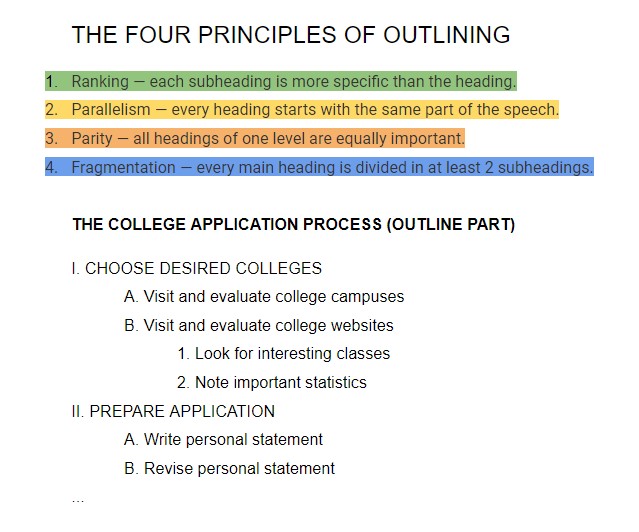
The most common format is a standard alphanumeric outline template. Headlines are labeled in the following order (from the first to the most nested one):
- (a) Lowercase letters in round brackets
For what you write in each point, you can use brief phrases or full sentences to summarize the idea.
The decimal outline structure is another format you can apply, and it looks like this:
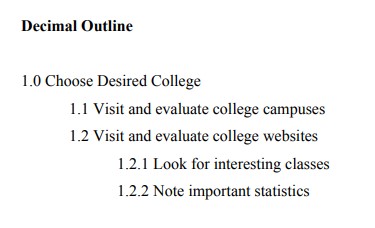
When organizing an essay, there are two primary types of outlines: topic outlines and sentence outlines .
A topic outline lists your essay’s main points and subpoints in short phrases or single words. As a result, it provides a clear, concise structure and helps you visualize the flow of the essay without getting into detailed sentences. This type of outline is mainly useful for shorter essays or when you have a strong comprehension of the subject and do not need to go into every point during this initial planning stage.
In contrast, a sentence outline has complete sentences for each main point and subpoint. This outlining approach offers a more detailed framework, allowing you to flesh out your ideas and ensure that each part of the essay is developed well. Sentence outlines are good for longer or more complex papers, where you need to clarify your thoughts and arguments in advance. By using full sentences, this outline type helps identify any gaps in logic or areas that need further analysis, making the actual writing process smoother and more efficient in the end.
Why is Outlining Important?
Reasons vary, but we usually use it to logically order all the data you collected during the brainstorming and researching stages. A good outline helps a lot in writing research papers, as you can easily keep track of all the relevant information. Even for oral presentations, it’s a great way to identify the strengths and weaknesses of their speech and make it more effective. To sum up, an outline’s core functions are:
- Guiding you during the writing phrase
- Helping you organize your thoughts and ideas
- Presenting material in a logical order
- Showing how your ideas link to one another
- Serving as an abstract for your paper
Outlines enhance thinking flow
Consider planning every next day before going to bed. You will realize that you undertake your daily activities without overthinking or second-guessing yourself because you know what to do every time. That is one of the proven life principles for most successful people. The same applies to paper writing. Your essays will feel like a walk in the park if you outline every major point beforehand.
Outlines save time
Time is a commodity that none of us have in abundance, especially considering the responsibilities students have to undertake daily. So why spend hours on essays when you have mounting academic work? You’d rather waste less time and still get good grades. That’s what essay outlines are for: saving time and improving your performance. Once you’ve planned out your essay, it takes less time to develop each idea.
Outlines improve grades
From students’ perspective, the whole point of sweating over an essay is to get the best grades, and an outline can help you do that. If you take time to brainstorm and jot down every major point you can raise in your essay, you will make fewer errors. If you arrange your ideas in an order that makes sense, your tutor will notice it and evaluate the paper accordingly.
How to Outline an Essay
Building an outline is an excellent way to ensure that every paragraph in your essay has a purpose. While outlining, you can see if a paragraph is essential or can be dropped without harm to your paper. It also checks how your argument or main idea is advancing, which will help you speed up the proofreading stage. Now that you learned how significant outlining is, let’s see how you can create one.
Before writing an outline, you should:
- Define the goal of your essay.
- Determine the target audience.
- Create the thesis statement.
Step 1: Research
The quality of your research determines the quality of your outline and your essay at large. That includes finding quotes from reputable sources or indicating the main supporting points to bolster your argument. Depending on your educational background, you might have to use different sources to expedite your research.
Any websites found on Google are unsuitable sources for papers written at a college or university level. Since the Internet is full of unverified information, it’s vital to ascertain your source’s credibility before referring to it. Examples of trusted sites include Google Scholar, Microsoft Academic, Science.gov, Refseek, and Oxford Academic.
Step 2: Organize
After choosing a topic and researching, it’s time to write the outline using all the gathered information. It should match the layout of the essay: an introduction, a body section, and a conclusion. Have you ever written down something but couldn’t read from your handwriting later on? This usually happens if you have bad handwriting or the information is too clustered to read. You don’t want to rely on such an outline, especially when pressed for time. So, you must organize your plan to match the essay structure .
Introduction
Some ways to start your introduction paragraph are anecdotes, proverbs or idioms, definitions, statistics, quotes, or facts. You can begin your essay outline by jotting down the main ideas for the introduction, which should also include a thesis statement. The point is to equip yourself with a road map, so short sentences should suffice.
Body paragraphs
Each body paragraph provides one idea that supports your thesis statement and is backed by facts, details, and examples. There will be more or fewer paragraphs here, depending on the essay volume. But, when writing a standard essay, you would usually need three body paragraphs, each of which should be in your outline. Remember that every paragraph must start with a topic sentence supported by two or three independent ideas with a link (transition) sentence at the end.
This paragraph summarizes every major point in the essay with some broader context. For a short paper, three to five sentences should be used for the concluding section of your paper.
Below is a template of a standard five-paragraph essay outline structure template that you can download by clicking on the button under the image.
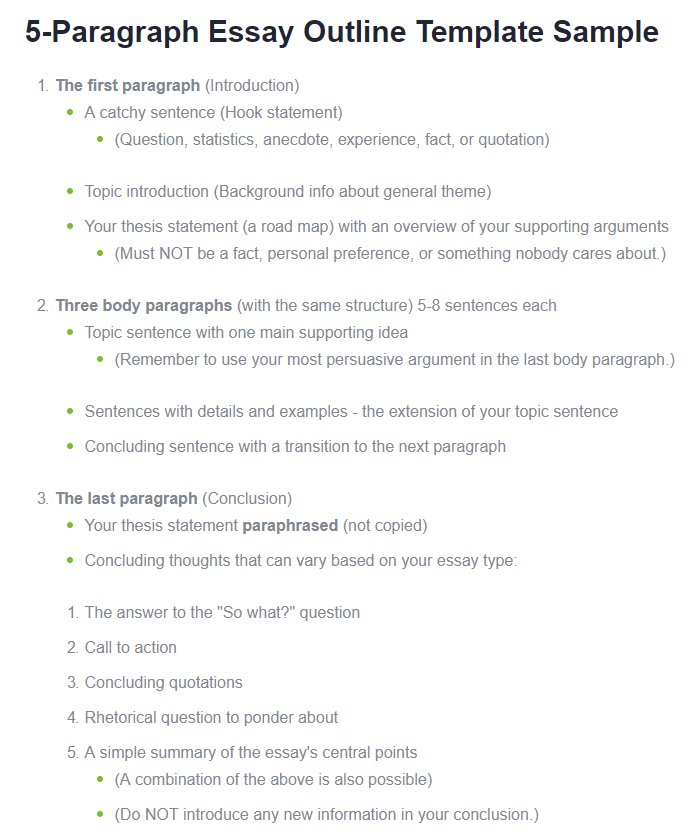
Once you’re done, remember to proofread and edit to ensure you haven’t missed something important.
Essay outline examples
Now that you know how to write an outline, analyze the samples below to better understand how to apply this theory in practice. Each sample essay outline was hand-picked to ensure it corresponds to all key principles of creating one.
CLICK OR TAP ON THE IMAGE TO DOWNLOAD IT IN PDF
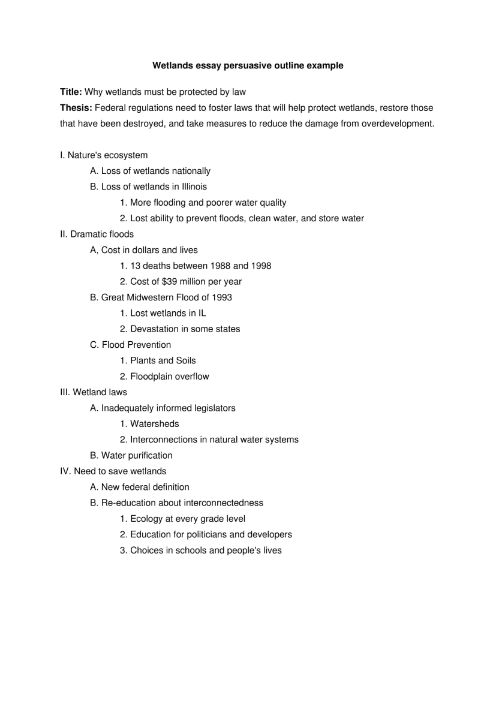
Argumentative essay outline example
Similar to persuasive essays, argumentative essays are designed to persuade the reader to accept a specific point of view. They require the writer to use relevant evidence and reasoning to support their arguments while addressing and refuting opposing viewpoints.
For example, an argumentative essay outline on the topic “The Necessity of Renewable Energy” could be structured as follows:
- A. Start with a striking statistic about current global energy consumption.
- B. Provide background on the reliance on non-renewable energy sources.
- C. Thesis: “In the face of escalating environmental crises and depleting non-renewable resources, transitioning to renewable energy sources emerges as an indispensable solution, not only to mitigate ecological damage but also to ensure long-term sustainability and economic viability for future generations.”
- 1. Detail the ecological damage caused by fossil fuels.
- 2. Highlight the contribution of non-renewable energy to global warming.
- 1. Describe the long-term environmental benefits of renewable sources.
- 2. Discuss technological advancements in renewable energy.
- 1. Address concerns about the high cost and practicality.
- 2. Provide evidence of decreasing costs and increasing efficiency.
- A. Reiterate the thesis in light of the arguments presented.
- B. Summarize the environmental and economic benefits.
- C. Concluding statement: Call to action for policy changes and individual responsibility.
Narrative essay outline example
Narrative essays tell a story, focusing on personal experiences and emotions. For instance, a narrative essay titled “My Journey to Becoming a Volunteer” could have the following example outline:
- A. Open with a personal anecdote about the desire to help others.
- B. Set the scene for the volunteer journey.
- C. Thesis: “My journey to becoming a volunteer was a transformative experience that reshaped my understanding of community and self, teaching me invaluable lessons in empathy, resilience, and the profound impact of selfless service on both personal growth and the well-being of others.”
- 1. Describe the initial motivation and decision-making process.
- 2. Mention key influences or events leading to the decision.
- 1. Narrate specific experiences and interactions during volunteering.
- 2. Reflect on challenges faced and how they were overcome.
- 1. Discuss the skills and insights acquired.
- 2. Illustrate how the experience changed perspectives on community and self.
- A. Summarize the journey and its impact.
- B. Reflect on the personal changes and growth experienced.
- C. Closing thoughts: The ongoing importance of volunteer work.
Compare and contrast essay outline example
Compare and contrast essays examine the similarities and differences between two subjects, offering a balanced view. For example, a compare and contrast essay on “Online Learning vs. Traditional Classroom” might follow this outline:
- A. Discuss the rise of online learning platforms.
- B. Contrast online and traditional classroom settings.
- C. Thesis Statement: “While both online learning and traditional classroom education aim to deliver quality education, they differ significantly in terms of their learning environments and teacher-student interactions, each offering unique advantages and challenges that cater to diverse learning needs and preferences.”
- 1. Compare the curriculum and teaching materials used in both settings.
- 2. Illustrate with examples of course content in both formats.
- 1. Detail the virtual setting of online learning vs. physical classrooms.
- 2. Discuss the impact of these environments on student engagement.
- 1. Compare the nature of interactions in online and traditional settings.
- 2. Examine the impact on student learning and participation.
- A. Recap the key similarities and differences.
- B. Reflect on the effectiveness of each mode of learning.
- C. Final thoughts: Future trends in education.
Bottom line
Here are three key tips for students creating essay outlines:
- Review Your Assignment: Start by thoroughly reading your assignment instructions. This helps you understand your essay type and any word count limits.
- Keep Your Title and Thesis Handy: At the top of your outline, write down your essay’s title and the full thesis statement. This keeps your main idea in clear view as you work.
- Take Notes During Research: As you research, jot down key points. These notes will be valuable when you’re building your essay outline.
Remember, essays vary widely, from argumentative and narrative to comparative and persuasive, each with its own goals and structure. Mastering the art of outlining is crucial for improving your writing skills and achieving higher grades. If you often struggle with organizing your thoughts or experience writer’s block, planning your essay before you start writing can be immensely helpful. With practice, you’ll be able to complete your assignments more quickly while maintaining high quality.
The earlier, the better. If you start researching without note-taking and creating an outline, you might do all that research in vain. You need to read a bit, find reputable sources that you will use, and analyze the evidence before planning. But, as soon as your argument starts shaping, you should start putting your thoughts on paper.
Planning is a bit individual. Some people benefit from it more than others. If you can generate ideas easily but struggle with the writing process, preparing a thorough outline will help. Conversely, if you’re having a hard time coming up with ideas, you might benefit more from writing right away. Overplanning can also be harmful when it doesn’t leave enough time to complete the paper.
- Walden University — Outlining
- Bow Valley College — Writing Support
- Purdue University — Types of Outlines
Was this article helpful?
Academic Editing and Proofreading
- What is Predatory Publishing?
- Tips to Self-Edit Your Dissertation
- Guide to Essay Editing: Methods, Tips, & Examples
- Journal Article Proofreading: Process, Cost, & Checklist
- The A–Z of Dissertation Editing: Standard Rates & Involved Steps
- Research Paper Editing | Guide to a Perfect Research Paper
- Dissertation Proofreading | Definition & Standard Rates
- Thesis Proofreading | Definition, Importance & Standard Pricing
- Research Paper Proofreading | Definition, Significance & Standard Rates
- Essay Proofreading | Options, Cost & Checklist
- Top 10 Essay Editing Services of 2023
Academic Research
- Research Paper Outline: Templates & Examples
- How to Write a Lab Report: Examples from Academic Editors
Academic Writing & Publishing
- Difference Between Paper Editing and Peer Review
- What are the different types of peer review?
- How to deal with rejection from a journal?
- Editing and Proofreading Academic Papers: A Short Guide
- Primary and Secondary Sources
- How to Carry Out Secondary Research
- The Results Section of a Dissertation
- Checklist: Is my Article Ready for Submitting to Journals?
- Types of Research Articles to Boost Your Research Profile
- The Top 5 Dos & Don’ts of Academic Writing | Useful Examples
- 8 Types of Peer Review Processes You Should Know
- The Ethics of Academic Research
- How to Create In-Text Citations and Reference Page in APA 7
- MLA 9th Edition Paper Format Guidelines
- How To Craft Winning Admission Essays
- How does LaTeX based proofreading work?
- How to Improve Your Scientific Writing: A Short Guide
- Chicago Title, Cover Page & Body | Paper Format Guidelines
- How to Write a Thesis Statement: Examples & Tips
- Chicago Style Citation: Quick Guide & Examples
- Top 10 Dissertation Editing Services of 2023
- How to Format a College Essay: Format Template & Tips
- APA Header, Cover Page & Body – Paper Format Guidelines
- The A-Z Of Publishing Your Article in A Journal
- What is Journal Article Editing? 3 Reasons You Need It
- 5 Powerful Personal Statement Examples (Template Included)
- Additional Resources
- Formatting Tips on MS Word for Dissertations
- Plagiarism: How to avoid it in your thesis?
- Final Submission Checklist | Dissertation & Thesis
- 7 Useful MS Word formatting tips for dissertation writing
- How to Write a MEAL Paragraph: Writing Plan Explained in Detail
- Top 10 Free Citation Generators in 2023 | Quick & Easy
- Citation and Referencing
- Citing References: APA, MLA, and Chicago
- Why is it Important to Cite Your Sources?
- How to Cite Sources in the MLA Format
- MLA Citation Examples: Cite Essays, Websites, Movies & More
- APA Citation Examples: The Bible, TED Talk, PPT & More
- 10 Best Free Plagiarism Checkers of 2023 [100% Free Tools]
- Citations and References: What Are They and Why They Matter
- Dissertation Writing Guide
- Writing a Dissertation Proposal
- Top 10 Best Academic Research Resources
- How to Prepare for Your Dissertation Defense
- The Acknowledgments Section of a Dissertation
- Abstract: An Introduction
- The Table of Contents Page of a Dissertation
- The Introduction Chapter of a Dissertation
- The Literature Review of a Dissertation
- How to Choose a Topic for Your Dissertation
- The Only Dissertation Toolkit You’ll Ever Need!
- 5 Thesis Writing Tips for Master Procrastinators
- How to Write a Dissertation | 5 Tips from Academic Editors
- The Title Page of a Dissertation
- The 5 Things to Look for in a Dissertation Editing Service
- Top 10 Dissertation Editing & Proofreading Services
- Why is it important to add references to your thesis?
- The Research Methodology Section of a Dissertation
- Thesis Editing | Definition, Scope & Standard Rates
- Essay Writing Guide
- How to Pick the Perfect Essay Topic
- Essential Research Tips for Essay Writing
- Top 10 Essay Writing Tools in 2023 | Plan, Write, Get Feedback
- How to Write an Impactful Personal Statement (Examples Included)
- What Is a Mind Map? Free Mind Map Templates & Examples
- How to Structure Your Essay
How to Write an Essay Outline: 5 Examples & Free Template
- How to Write an Essay Header: MLA and APA Essay Headers
- What Is an Essay? Structure, Parts, and Types
- How to Write an Essay in 8 Simple Steps (Examples Included)
- 8 Types of Essays | Quick Summary with Examples
- Expository Essays | Step-by-Step Manual with Examples
- Narrative Essay | Step-by-Step Guide with Examples
- How to Write an Argumentative Essay (Examples Included)
- Guide to a Perfect Descriptive Essay [Examples & Outline Included]
- How to Start an Essay: 4 Introduction Paragraph Examples
- How to Write a Conclusion for an Essay (Examples Included!)
- Test Post for HTML Codes
Still have questions? Leave a comment
Add Comment

Checklist: Dissertation Proposal
Enter your email id to get the downloadable right in your inbox!

Examples: Edited Papers
Need editing and proofreading services.

abcdefghijlk
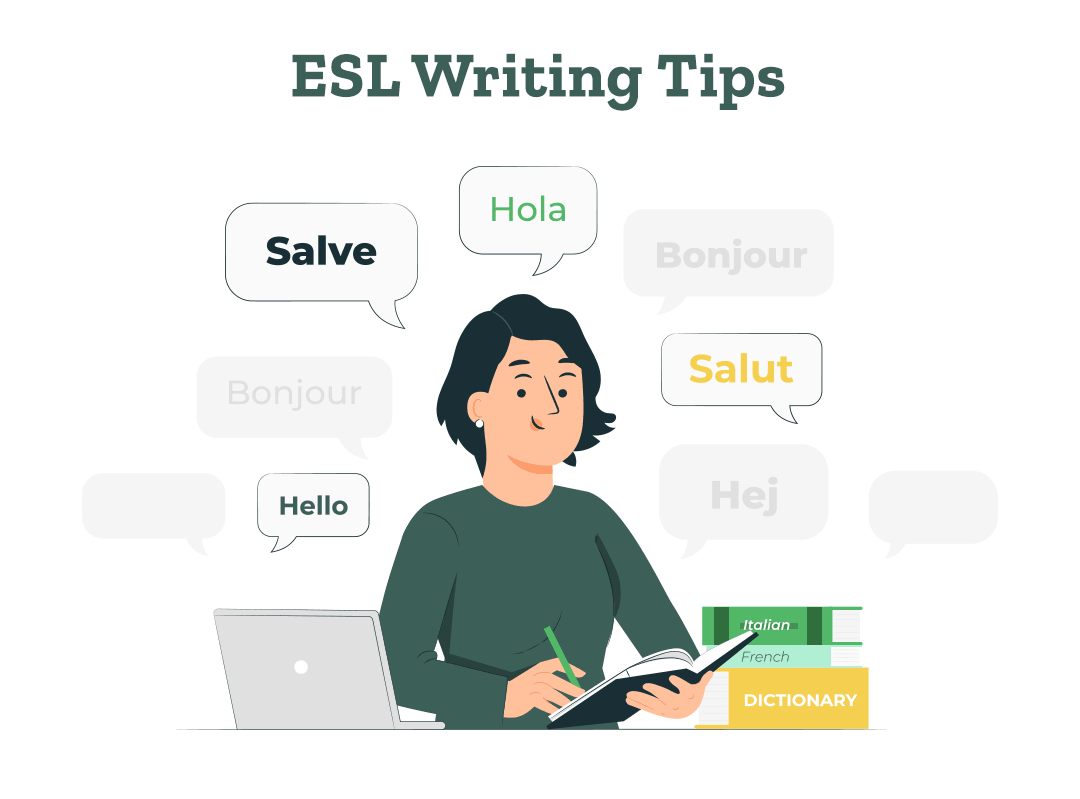
Editing & Proofreading for Authors
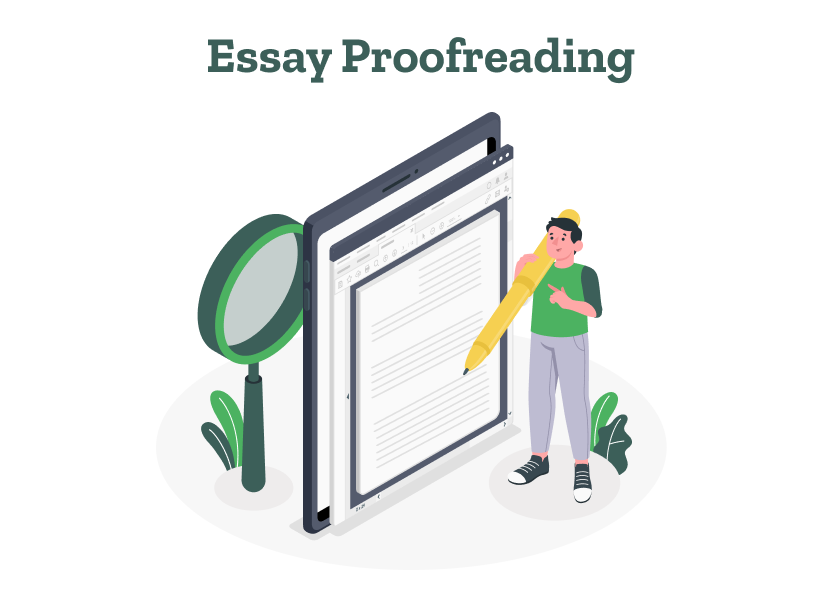
- Tags: Academic Writing , Essay
Creating a clear and organized essay is not easy, but making an outline can help. By arranging your ideas in a logical and coherent way, an essay outline can guide you in effectively structuring your essay.
Whether you’re working on a school or college assignment, take the time to create an outline. It can help you overcome the challenges of organizing your thoughts while writing. In this article, we’ll take a look at how to create an essay outline with the help of some useful examples and a downloadable template.
What is an essay outline?
An outline acts as a blueprint for your essay, presenting the structure and content of each paragraph and showing how they connect. By creating an outline, you can streamline the writing process and minimize the need for revisions. It can also help you develop strong points to support your thesis statement .
Typically, an outline is created after establishing a working thesis statement and gathering relevant information. The collected information is then organized into a logical flow that can be expanded into a structured essay.
Why is it important to create an essay outline?
An essay outline not only gives structure to your essay but also helps effectively link its parts. It helps create a logical flow for your essay and also helps identify its primary components. Let’s take a look at this in detail.
1. Sets a logical order
To create a well-structured and impactful essay, the arrangement of information is key. Creating an essay outline makes it easier to organize bits of information from general to specific.
Start off by creating a broad thesis statement or central idea. Then move on to providing examples or pieces of information that support this statement or elaborate on it. This method also provides a comprehensive overview of your essay and helps identify any missing bits of information.
2. Generates greater impact
The primary goal of your essay is to effectively present information that supports your thesis statement. If your essay is haphazardly structured, the message of the thesis statement can get lost.
In order to present a coherent message, determine the important bits of information that best support your thesis statement and organize them logically. Then elaborate on these bits to create a flow. This not only creates a greater impact but also makes your final essay more convincing.
3. Leads to smoother transitions
Transitions are the bridges that connect your ideas and ensure that your argument flows smoothly. However, creating smooth transitions from one point to another can be quite challenging.
A college essay outline helps you identify where you need to include transitions and what type of transition you should use to connect your ideas effectively. Creating smooth, logical, and cohesive transitions is crucial in ensuring that readers can easily follow your train of thought and grasp your argument.
How to write an essay outline
After conducting all the necessary research, it is time to narrow down the central idea of your essay. Make sure that the scope of your idea is neither too broad nor too narrow.
Select the main bits of information that elaborate on this central idea and organize them in a logical manner. Then provide specific examples to back them up. Let’s take a detailed look at these steps.
1. Figure out the central message or the thesis statement of your essay.
Picking out a central idea or generic point for your essay can help create a base you can elaborate upon.
You can start with a broad idea or stance and then research the specific bits of information that support this idea and provide more information on it.
2. Identify the main points or arguments.
After collecting the necessary information to elaborate on your central idea, identify the broad points that give it substance.
These points will form the headings of the essay. They should be broad enough to cover major themes, but specific enough to provide a clear focus for each section.
3. Organize your headings.
Decide the logical flow of your essay and arrange your headings in an organized manner.
It is crucial to have obvious starting and ending points, but the body can be organized in a way you consider to be the most impactful. Depending on the type of essay, your headings can be arranged chronologically, on the basis of importance, or from general to specific.
4. Provide examples and evidence to support the headings.
Once the headings are created and organized, provide statistics, anecdotes, and examples to back them up. These specific pieces of information can be elaborated upon while writing your first draft.
You can use this general essay outline format to create your own
Essay outline template
To help you write a logical, well-structured, impactful essay, we have developed this fool-proof, comprehensive essay outline template. It will help you categorize all your essential information into well-structured, organized headings and subheadings.
The template includes an introduction, three body paragraphs, an optional paragraph for a counter-argument, and a conclusion. Under each of these headings, there are relevant subheadings that are applicable to all types of essays.
The template uses an alphanumeric format, with Roman numerals for the headings and capital letters for the subheadings.
Download Free Outline Essay Template
Essay outline examples .
Essays are highly versatile pieces of writing. They include various types, such as persuasive essays, compare and contrast essays, analytical essays, and cause-and-effect essays.
But most of these essay types are a combination or a derivation of these four main types of essays. They include narrative, descriptive, argumentative, and expository essays.
Each of these essays serves a different purpose and is structured differently. Let’s understand the purpose of each of these essay types with the help of relevant essay outline examples:
1. Narrative essay outline
A narrative essay outline is a highly personalized outline that reflects your unique experiences, feelings, and observations.
The goal of this outline is to tell an impactful story with the help of vivid descriptions and sensory details that engage the reader’s attention.
Narrative essay outline example
Let us better understand the narrative essay outline with the help of an example. The following example is a personal narrative about growing up as an immigrant child.
I. Introduction
A. A vivid description of the moment I found out I was moving to a new country.
B. Brief explanation of my background and reasons for immigrating.
C. Thesis statement: The challenges and opportunities I faced as an immigrant in a new country.
A. Struggles in adjusting to a new culture.
1. Language barriers I faced in school and everyday life.
2. Differences in cultural norms and expectations.
B. Navigating a new education system
1. Differences in teaching styles and expectations.
2. Adjusting to a new curriculum and grading system.
C. Finding a sense of belonging
1. Challenges in making friends and building relationships.
2. Coping with homesickness and missing family and friends.
III. Conclusion
A. Reflection on my journey as an immigrant
1. Lessons learned and personal growth.
2. Significance of the experience.
B. Acknowledgment of my resilience and determination.
1. Overcoming challenges and achieving success.
2. Encouragement for others facing similar challenges.
C. Memorable closing statement related to my journey.
2. Argumentative essay outline
An argumentative essay outline requires you to take a clear stance on a topic and provide strong evidence to support it.
The goal of this outline is to convince the reader to see your point of view on a controversial topic.
Argumentative essay outline example
The following example shows us how the internet is beneficial to the mental development of school children. It establishes the internet to be a valuable resource for children.
A. A surprising statistic or fact about children and their use of the internet.
B. Brief explanation of the prevalence of the internet in modern society and its impact on children.
C. Thesis statement: Despite concerns about safety and privacy, the internet is a valuable resource for children due to its educational opportunities, communication tools, and access to diverse perspectives.
A. Education opportunities.
1. Access to information and resources that may not be available in traditional classroom settings.
2. Interactive tools and games that can reinforce learning and engage children in new ways.
B. Communication tools
1. Social media and messaging platforms that allow children to connect with peers and mentors.
2. Online forums and discussion groups that foster collaboration and problem-solving skills.
C. Exposure to diverse perspectives
1. Access to a variety of viewpoints and perspectives from around the world.
2. Exposure to different cultures and ways of thinking can foster empathy and understanding.
III. Counterarguments and Rebuttal
A. Potential safety concerns and risks associated with internet use
1. Explanation of safety measures and precautions that can mitigate these risks.
2. Rebuttal of the idea that the risks outweigh the benefits.
B. Potential negative effects on cognitive and social development
1. Explanation of the positive effects of internet use on cognitive development and social skills.
2. Rebuttal of the idea that the internet is inherently harmful to children.
IV. Conclusion
A. Restatement of thesis statement and main points of the argument.
B. Reflection on the importance of the internet as a valuable resource for children.
C. Final thoughts and call to action for readers to embrace the benefits of internet use for children.
3. Expository essay outline
An expository essay outline requires you to provide a detailed overview of a subject from all angles. It is used to test your knowledge of a particular subject.
The purpose of this essay outline is to inform, explain, or describe a topic or idea, rather than to persuade the reader or share personal opinions.
This type of essay is often used in academic settings, such as in writing assignments, research papers, or even textbooks.
Expository essay outline example
The following example provides us with information on SONAR technology, its uses, its impact on the environment, as well as its benefits.
A. A brief explanation of the significance of SONAR and its impact on underwater navigation and detection.
B. A definition of SONAR and its origins, and the history of its development and uses.
C. Thesis statement: This essay will provide a detailed overview of the use of SONAR technology, its applications, and its impact on various fields.
A. Explanation of SONAR technology
- Basic principles of SONAR.
- Types of SONAR and how they work.
B. Applications of SONAR technology
1. Military applications, including submarine detection and mine detection.
2. Commercial applications, including underwater mapping and exploration, and marine life observation.
C. Advantages and disadvantages of SONAR technology
1. Advantages, such as accuracy and range.
2. Disadvantages, such as interference and environmental impact.
A. Safety and environmental concerns
1. Explanation of the measures taken to minimize the environmental impact of SONAR technology.
2. Rebuttal of the idea that the benefits of SONAR technology are outweighed by its environmental impact.
B. Potential misuse or abuse of SONAR technology
1. Explanation of regulations and laws governing the use of SONAR technology.
2. Rebuttal of the idea that the potential misuse of SONAR technology justifies limiting its applications.
B. Reflection on the significance of SONAR technology and its impact on various fields.
C. Final thoughts and call to action for readers to learn more about SONAR technology and its applications.
4. Descriptive essay outline
A descriptive essay outline requires you to create a detailed and sensory-rich description of a person, place, object, event, or experience.
The goal is to provide the reader with a visceral experience that engages their senses and imagination.
Descriptive essay outline example
The following example provides a highly immersive experience and uses multiple sensory descriptors to describe the summers spent by the writer at their grandmother’s farm.
A. Description of a typical summer day at grandma’s farm.
B. Brief overview of the location and purpose of the farm.
C. Thesis statement: Summers spent at grandma’s farm were some of the most memorable and enjoyable times of my childhood, thanks to the idyllic setting and the rich sensory experiences it provided.
II. Body Paragraph 1: The Scenery
A. Topic sentence: The farm was located in a picturesque rural area surrounded by rolling hills and green pastures.
B. Sensory details:
1. Visual: Describe the lush greenery, the colorful flowers, and the endless expanse of blue sky.
2. Auditory: Mention the sound of the chirping birds, the rustling leaves, and the occasional mooing of cows.
3. Olfactory: Describe the fragrant smell of fresh hay and the earthy aroma of the soil.
4. Tactile: Describe the feeling of the warm sun on the skin and the softness of the grass underfoot.
III. Body Paragraph 2: The Activities
A. Topic sentence: The farm provided numerous activities and tasks that kept me busy and engaged throughout the day.
1. Visual: Describe the sight of the cows grazing, the chickens clucking, and the horses trotting.
2. Auditory: Mention the sound of the milking machine, the creaking of the barn doors, and the whinnying of the horses.
3. Olfactory: Describe the smell of the freshly baked pies, the wood smoke from the bonfire, and the scent of the freshly cut grass.
4. Tactile: Describe the feeling of the cow’s rough tongue licking my hand, the warmth of the freshly laid eggs, and the rough texture of the hay bales.
IV. Body Paragraph 3: The People
A. Topic sentence: The farm was a family affair, and spending time with my grandmother and other relatives was a highlight of the summer.
1. Visual: Describe the sight of my grandmother cooking in the kitchen, my cousins running through the fields, and my uncles fixing machinery.
2. Auditory: Mention the sound of laughter and conversation around the dinner table, the chatter of family members working together, and the clinking of dishes.
3. Olfactory: Describe the smell of home-cooked meals, the familiar scents of family members, and the aroma of freshly brewed coffee.
4. Tactile: Describe the feeling of hugs from family members, the rough texture of my grandfather’s hand, and the warmth of a family embrace.
V. Conclusion
A. Restate thesis: Summers spent at grandma’s farm were truly unforgettable, filled with vivid sensory experiences and cherished memories.
B. Summarize main points: Recap the main sensory details and experiences shared in the essay.
C. Final thoughts: Reflect on the impact of the farm on the writer’s life and express gratitude for the memories made there.
Here are some related articles that you might find interesting:
- How to Write an Essay in 8 Simple Steps
Frequently Asked Questions
What is an outline for an essay, what is the one important rule of essay outlining, what are the four main components to keep in mind while constructing an essay outline, what are the basic principles of essay outlining, what is the purpose of an outline.
Found this article helpful?

Leave a Comment: Cancel reply
Your email address will not be published.

Your Organization Needs a Technical Editor: Here’s Why

Writing for the Web: How Your Readers Want to Read Content

Writing Contests 2023: Cash Prizes, Free Entries, & More!.

Writing Content to Achieve a Higher Readability
Subscribe to our Newsletter
How to Copyright Your Book?
If you’ve thought about copyrighting your book, you’re on the right path.
© 2024 All rights reserved
- Terms of service
- Privacy policy
- Self Publishing Guide
- Pre-Publishing Steps
- Fiction Writing Tips
- Traditional Publishing
- Academic Writing and Publishing
- Partner with us
- Annual report
- Website content
- Marketing material
- Job Applicant
- Cover letter
- Case studies
How to Write an Essay Outline + Essay Outline Examples
Download for free.
| Add to Folder | |
|---|---|
| creative writing | |
| children's book | |
| activities | |
| classroom tools | |
| language arts and writing | |
| vocabulary |
How to Write an Essay Outline + Essay Outline Examples
Writing an essay can seem like a daunting task, but one of the best ways to tackle this challenge is to organize your ideas into a well-structured essay outline. This guide will walk you through the process of creating an essay outline, complete with essay outline examples, to ensure your next essay is a masterpiece.
We’ve compiled a variety of essay outline examples to help you understand how to structure your own essay. We'll cover persuasive essays, narrative essays, descriptive essays, expository essays, and even provide a sample research paper outline. Each example will provide you with an idea of how to lay out the structure and details for each type of essay.
Looking for a printable list of essay outline examples? Our printable PDF features essay outline examples and templates that your students can use as examples when writing research papers, or as a supplement for an essay-writing unit
Why write an essay outline?
An outline serves as the skeleton of your essay, giving you a clear and organized path to articulate your thoughts. Not only does it make writing an essay significantly easier, but it also allows you to present your arguments coherently and effectively.
An essay outline will help you organize your main ideas and determine the order in which you are going to write about them.

Types of essay outlines
Several types of essay outlines can be used when writing an essay. The two most common types are the alphanumeric outline and the decimal outline.
An alphanumeric outline typically uses Roman numerals, capital letters, Arabic numerals, and lowercase letters, in that order. Each level provides a different level of specificity. This structure is a very effective way to think through how you will organize and present the information in your essay. It also helps you develop a strong argumentative essay.
Alternatively, a decimal outline uses only numbers, and each subsection is a decimal subdivision of the main section. This type of outline is often used in scientific papers.
Persuasive essay outline example
In the following section, we'll explore a persuasive essay outline example on competitive swimming. The purpose of a persuasive essay is to convince the reader of a particular point of view or idea, using compelling arguments and evidence.
In this case, the argument is that competitive swimming is an ideal sport for kids. The essay will present a series of arguments to support this view, demonstrating the various benefits of competitive swimming for children.
Competitive Swimming, an Ideal Sport for Kids
Introduction
Start your argumentative essay outline by stating your point of view and/or presenting your persuasive argument.
Thesis: Competitive swimming is a great alternative to other youth sports.
Body Paragraph 1
Introduce your primary persuasive argument and provide supporting details in your argumentative essay outline.
Topic Sentence: Competitive swimming provides the same benefits as other sports.
- Detail Sentence 1: It is good exercise and builds muscular strength.
- Detail Sentence 2: It promotes cooperation among team members, especially in relays.
Body Paragraph 2
Introduce a secondary argument and provide supporting details.
Topic Sentence: Competitive swimming provides some unique additional benefits.
- Detail Sentence 1: Swimming is an important skill that can be used forever.
- Detail Sentence 2: Swimming poses a reduced risk of injury.
- Detail Sentence 3: Each swimmer can easily chart his or her own progress.
Conclude your essay writing with a summary of the thesis and persuasive arguments. Brainstorming details that support your point-of-view is a great way to start before creating your outline and first draft.
Concluding Sentence: There are many reasons why competitive swimming is a great alternative to other youth sports, including...
Narrative essay outline example
In the following section, we will examine a narrative essay outline example titled "How Losing a Swim Meet Made Me a Better Swimmer." Narrative essays aim to tell a story, often about a personal experience, to engage the reader and convey a particular point or lesson.
In this case, the narrative revolves around the author's personal journey of improvement and self-discovery through swimming. The essay will illustrate how an initial setback served as a catalyst for significant improvement and personal growth.
How Losing a Swim Meet Made Me a Better Swimmer
Introduce the subject of your narrative essay using a thesis statement and a plan of development (POD).
Thesis: The first time I participated in a competitive swim meet, I finished in last place. With more focused training and coaching, I was able to finish 2nd in the State Championship meet.
Plan of development: I was very disappointed in my results from the first meet, so I improved my training and fitness. This helped me swim better and faster, which helped me to greatly improve my results.
Set the scene and provide supporting details. Again, start by brainstorming different ways to begin; then go ahead and craft an outline and a first draft.
Topic Sentence: I was embarrassed at finishing last in my first competitive swim meet, so I began working on ways to improve my performance.
- Detail Sentence 1: I spent extra time with my coach and the team captains learning how to improve my technique.
- Detail Sentence 2: I started running and lifting weights to increase my overall fitness level.
Provide additional supporting details, descriptions, and experiences to develop your general idea in your essay writing.
Topic Sentence: Over time, my results began to improve and I was able to qualify for the state championship meet.
- Detail Sentence 1: My technique and fitness level made me faster and able to swim longer distances.
- Detail Sentence 2: I steadily got better, and I began winning or placing in the top 3 at most of my meets.
- Detail Sentence 3: My results improved to the point that I was able to qualify for the state championship meet.
Body Paragraph 3
The next step in the writing process is to provide additional supporting details, descriptions, and experiences. You can then divide them up under different headings.
Topic Sentence: With my new confidence, techniques, and fitness level, I was able to finish 2nd at the state championship meet.
- Detail Sentence 1: I was able to swim well against a higher level of competition due to my training and technique.
- Detail Sentence 2: I was no longer embarrassed about my last-place finish, and was able to use it as motivation!
Conclude the narrative essay with a recap of the events described or a reflection on the lesson learned in the story. Briefly summarize the details you included under each heading.
Concluding Sentence: I used my last-place finish in my first competitive swim meet as motivation to improve my performance.
Descriptive essay outline example
We will now delve into a descriptive essay outline example. Descriptive essays aim to create a vivid and detailed description of a person, place, object, or event to paint a picture for the reader. The intention is to immerse the reader in the subject matter fully.
In this case, the essay provides an in-depth description of a visit to the Hockey Hall of Fame in Toronto. The essay will use sensory and descriptive details to create a vivid and memorable experience for the reader.
Visiting the Hockey Hall of Fame
Introduce the subject of your descriptive essay with a thesis statement covering the person, place, object, etc. you are writing about.
Thesis: The Hockey Hall of Fame is full of sights, sounds, and experiences that will delight hockey fans of all ages.
Set the scene and provide factual details.
Topic Sentence: The Hockey Hall of Fame is located in Toronto, Canada and features exhibits from amateur and professional hockey.
- Detail Sentence 1: The Hall is located in downtown Toronto and is visited by 1 million people every year.
- Detail Sentence 2: You can see exhibits ranging from the early beginnings of the sport to the modern NHL and Olympics.
Provide additional sensory details, descriptions, and experiences.
Topic Sentence: There are many types of exhibits and shows, including activities you can participate in.
- Detail Sentence 1: Player statues, plaques, and jerseys decorate the walls in every room of the Hall.
- Detail Sentence 2: Many of the exhibits have movies and multimedia activities that make you feel like you're part of the game.
- Detail Sentence 3: You can even practice shooting pucks on virtual versions of some of the game's greatest goalies!
Conclude the essay with a paragraph that restates the thesis and recaps the descriptive and sensory details.
Concluding Sentence: The Hockey Hall of Fame is an experience that combines the best sights, sounds and history of the game in Toronto.
Expository essay outline example
In the following section, we will explore an example of an expository essay. An expository essay aims to explain or describe a topic using logic. It presents a balanced analysis of a topic based on facts—with no references to the writer’s opinions or emotions.
For this example, the topic is "Why The School Year Should be Shorter". This essay will use logic and reason to demonstrate that a shorter school year could provide various benefits for students, teachers, and school districts.
Why The School Year Should be Shorter
Introduce the primary argument or main point of an expository essay, or other types of academic writing, using a thesis statement and context.
Thesis: The school year is too long, and should be shortened to benefit students and teachers, save districts money, and improve test scores and academic results. Other countries have shorter school years, and achieve better results.
Describe the primary argument and provide supporting details and evidence.
Topic Sentence: A shorter school year would benefit students and teachers by giving them more time off.
- Detail Sentence 1: Students and teachers would be able to spend more time with their families.
- Detail Sentence 2: Teachers would be refreshed and rejuvenated and able to teach more effectively.
Provide additional supporting details and evidence, as in this essay outline example.
Topic Sentence: A shorter school year would save school districts millions of dollars per year.
- Detail Sentence 1: Districts could save money on energy costs by keeping schools closed longer.
- Detail Sentence 2: A shorter school year means much lower supply and transportation costs.
- Detail Sentence 3: Well-rested and happy students would help improve test scores.
Provide additional or supplemental supporting details, evidence, and analysis, as in the essay outline example.
Topic Sentence: Shortening the school year would also provide many benefits for parents and caregivers.
- Detail Sentence 1: A shorter school year would mean less stress and running around for parents.
- Detail Sentence 2: Caregivers would have more balance in their lives with fewer days in the school year.
Conclude the essay with an overview of the main argument, and highlight the importance of your evidence and conclusion.
Concluding Sentence: Shortening the school year would be a great way to improve the quality of life for students, teachers, and parents while saving money for districts and improving academic results.
Sample research paper outline
Now let’s dive into a research paper outline. Unlike a typical essay, a research paper presents a thorough and detailed study on a specific topic. However, it shares the same foundation with an essay in terms of structuring the ideas logically and coherently. The outline for a research paper includes an introduction, a series of topic points that cover various aspects of the main topic, and a conclusion.
This research paper will explore the background of Mt. Everest, the major explorers who attempted its summit, and the impact of these expeditions on Mt. Everest and the local community.
The Conquest of Mt. Everest
- Location of Mt. Everest
- Geography of the Surrounding Area
- Height of the mountain
- Jomolungma (Tibetan name)
- Sagarmatha (Nepalese name)
- The number of people who have climbed Everest to date
- First to reach the summit (1953)
- Led a team of experienced mountain climbers who worked together
- Norgay was an experienced climber and guide who accompanied Hillary
- Sherpas still used to guide expeditions
- Leader of the failed 1996 expedition
- Led group of (mainly) tourists with little mountain climbing experience
- Loss of trees due to high demand for wood for cooking and heating for tourists.
- Piles of trash left by climbing expeditions
- Expedition fees provide income for the country
- Expeditions provide work for the Sherpas, contributing to the local economy.
- Introduction of motor vehicles
- Introduction of electricity
The Everest essay outline template is based on a research paper submitted by Alexandra Ferber, 9th grade.
Happy writing!
Writing an essay outline is a crucial step in crafting a well-structured and coherent essay. Regardless of the type of essay - be it persuasive, narrative, descriptive, expository, or a research paper - an outline serves as a roadmap that organizes your thoughts and guides your writing process. The various essay outline examples provided above serve as a guide to help you structure your own essay. Remember, the key to a great essay lies not just in the content but in its organization and flow. Happy writing!
Featured High School Resources

Related Resources

- TemplateLab
Essay Outline Templates
37 outstanding essay outline templates (argumentative, narrative, persuasive).
Writing an essay can seem like an overwhelming task, and planning beforehand is essential to success. An essay outline will help you to structure and organize your essay so that it flows coherently. Essay outlines work for all kinds of essays and will save you time and stress.
There are various different ways to structure an essay, and using an essay outline template allows you to decide on the best structure for your essay. Whether you want a balanced argument, or if you’re trying to persuade someone of your idea, then there will be an essay outline that works for you.
Table of Contents
- 1 Essay Outline Templates
- 2 What is an Essay Outline Template?
- 3 Essay Outline Examples
- 4 What Different Types of Essay Outline Templates Are Available?
- 5 Why are Essay Outlines important?
- 6 How Do You Structure an Outline for an Essay?
- 7 Essay Outline Samples
- 8 What is the Format of a Five-Paragraph Essay Outline?
- 9 How to Write an Effective Essay Outline
- 10 Free Essay Outlines
- 11 Create an Effective Outline Using an Essay Outline Template
You can download and print one of our free essay outline templates to help you plan the perfect essay.
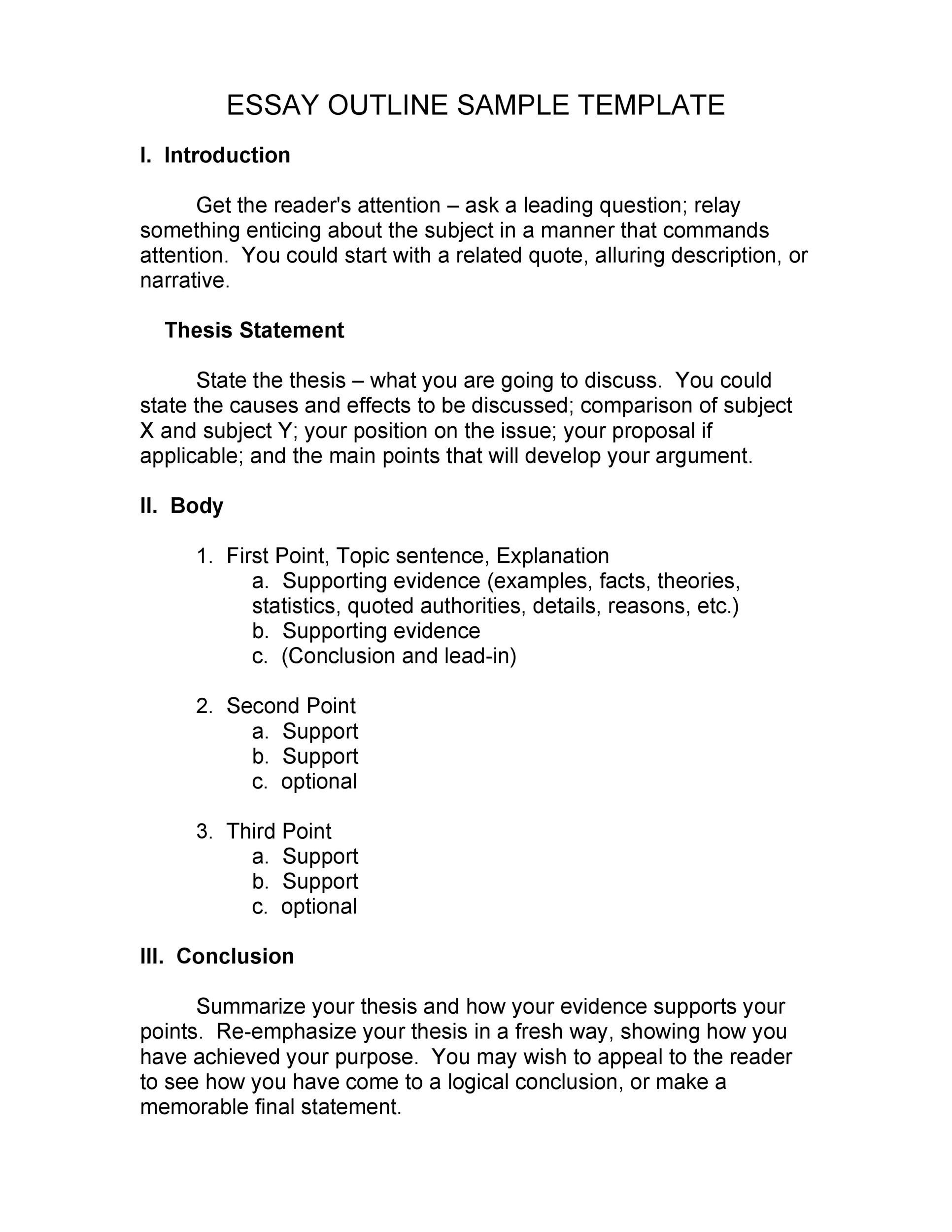
What is an Essay Outline Template?
An essay outline template is essentially the essay plan. It provides students with a clear structure before they write their essay, including all of the main points that are necessary for their writing.
Planning an essay outline beforehand makes the process of essay writing a lot less daunting, providing students with a guideline to follow whilst writing their essays in detail. In the world of academic writing , an essay outline serves as a tool to organize and structure thoughts before delving into the actual writing process. Many students underestimate the significance of creating an essay outline, often resulting in disorganized and incomprehensible essays.
Essay Outline Examples
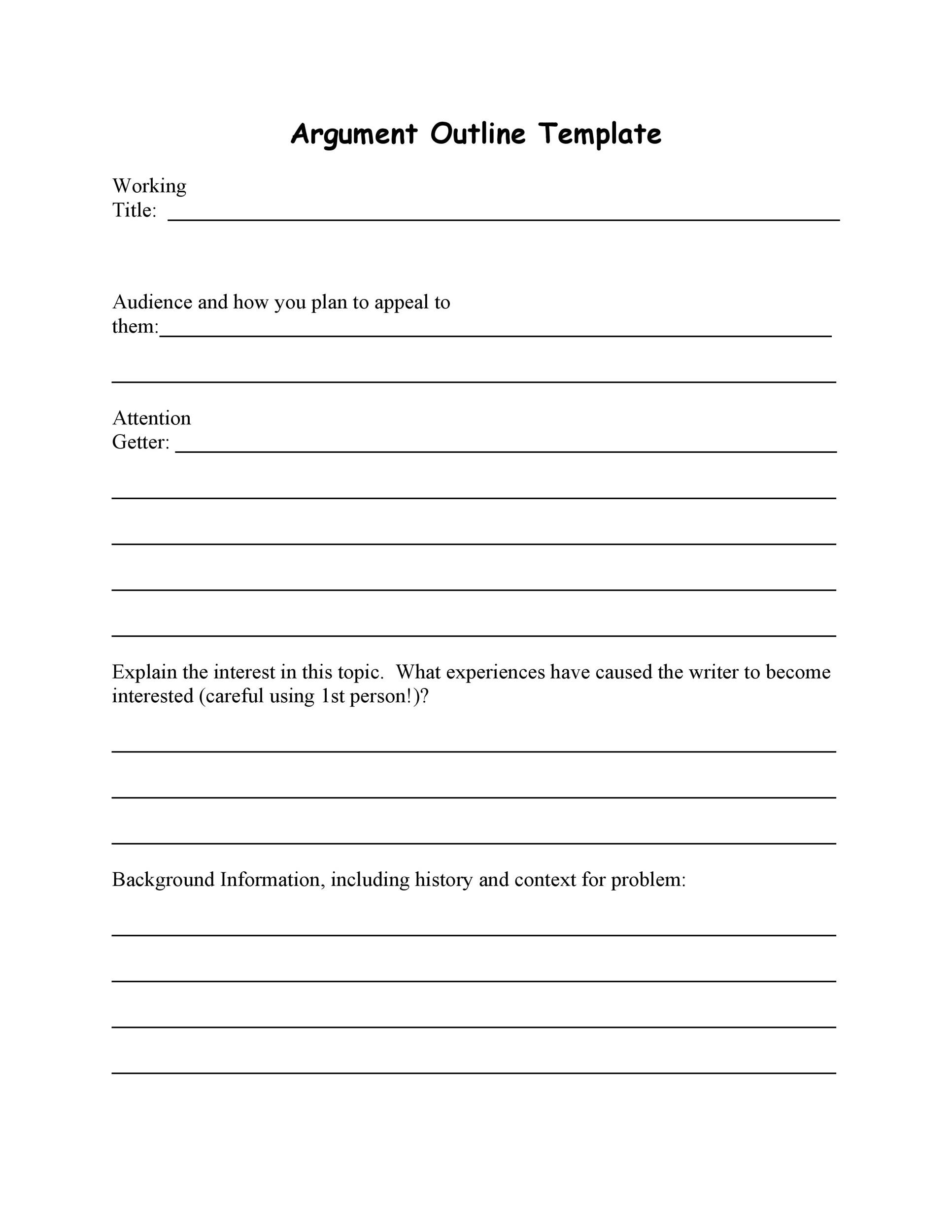
What Different Types of Essay Outline Templates Are Available?
Essay outlines can be used for any college essay, research papers, a contrast essay, speech writing, or an expository essay. There are a range of essay outline templates to use, and they vary depending on the style of essay you are writing. These include:
- Argumentative essay outline
- Narrative essay outline
- Contrast essay outline
- Literary analysis essay outline
- Persuasive essay outline
- Expository essay outline
- College essay outline
- Descriptive essay outline
- Reflective essay outline
Depending on the purpose of your essay, there will be a different structure to suit your writing and your writing process. For example, an argumentative essay outline may follow a more traditional five-paragraph essay outline, while a literary analysis essay may follow a more detailed essay outline template.
Why are Essay Outlines important?
Of course, you can write an essay without planning. However, it will likely read as unstructured and lacking in coherence. Essays that follow an essay outline template present as more well-researched, clearer, and with a thoughtful structure throughout.
- Planning makes perfect If you are writing to argue a point or explore a range of viewpoints, essay outlines are crucial to prepare before you begin writing in detail. Writing should not be an immediate, quick process; the best essays are drafted, re-drafted, edited, and finalized. If you use an essay outline, this will be reflected in the quality of your work. As a teacher, it is clear to me when students have not taken the time to plan their work. Their writing seems messy and rushed. Essay outlines provide structure and balance to any long piece of writing.
- Save time during the writing process Planning is the hard part of essay writing. During the planning process, you will be brainstorming your ideas and cultivating your overall viewpoint or argument. This means that when you come to write the essay, those ideas are already there. All you need to do is formulate them into sentences and paragraphs. An essay outline makes the process of writing the essay itself so much simpler. With the essay outline template, you will have the bulk of your ideas and the structure of your essay there to follow. It will save you time when it comes to writing the essay out in full.
How Do You Structure an Outline for an Essay?
Depending on the assignment, essays can follow a range of structures, and there are many different ways to structure an essay outline.
Before you begin to structure your essay outline, there are a few things to consider:
- Check your assignment guidelines . Your teacher or professor may have specified a certain number of words or pages for the essay, which can affect how you structure it.
- Consider the purpose of the essay. Is it to argue, is it a persuasive essay, or is it to reflect upon something? This will greatly help you to form and structure your essay, as you may need to compare and contrast ideas throughout your writing.
- Who is your audience? If this essay is purely for academic purposes, then your essay may follow a more traditional structure. However, if your essay is for a speech or a college application, then the structure may be more unconventional and include more of your own thoughts and experiences.
While there may be variations in essay outline structures depending on the specific requirements of the assignment, some general guidelines can be followed. You should edit and adjust your essay structure depending on the tone, audience, and purpose of your essay.
Typically, an effective essay outline comprises three primary sections: the introduction, the body paragraphs, and the conclusion. Each of these sections serves a unique purpose and contributes to the overall coherence of the essay.
- Introduction The introduction section of an essay outline introduces the topic and provides relevant background information to engage the reader. It also includes the thesis statement, which presents the main argument or claim of the essay. To structure the introduction in the outline effectively, writers can utilize a hook to grab the reader’s attention, provide context, and end with a strong thesis statement.
- Body Paragraphs The body paragraphs section of the essay outline supports the thesis statement with relevant evidence and arguments. The number of body paragraphs may vary depending on the required length of the essay. However, it is common to have three body paragraphs, each focused on a specific supporting point. In the outline, writers can include subpoints, evidence, and examples for each body paragraph to ensure a coherent and logical flow of ideas.
- Conclusion The conclusion section of the essay outline summarises the main points discussed in the body paragraphs and restates the thesis statement. The conclusion should not be an afterthought in the essay writing process. This part of the essay helps to tie all of your ideas together and is reflective of a well-structured essay. It is crucial to end the essay on a strong note, leaving a lasting impression on the reader. To structure the conclusion in the outline, writers can briefly restate the thesis, review the main points, and provide a final thought or call to action.
Essay Outline Samples
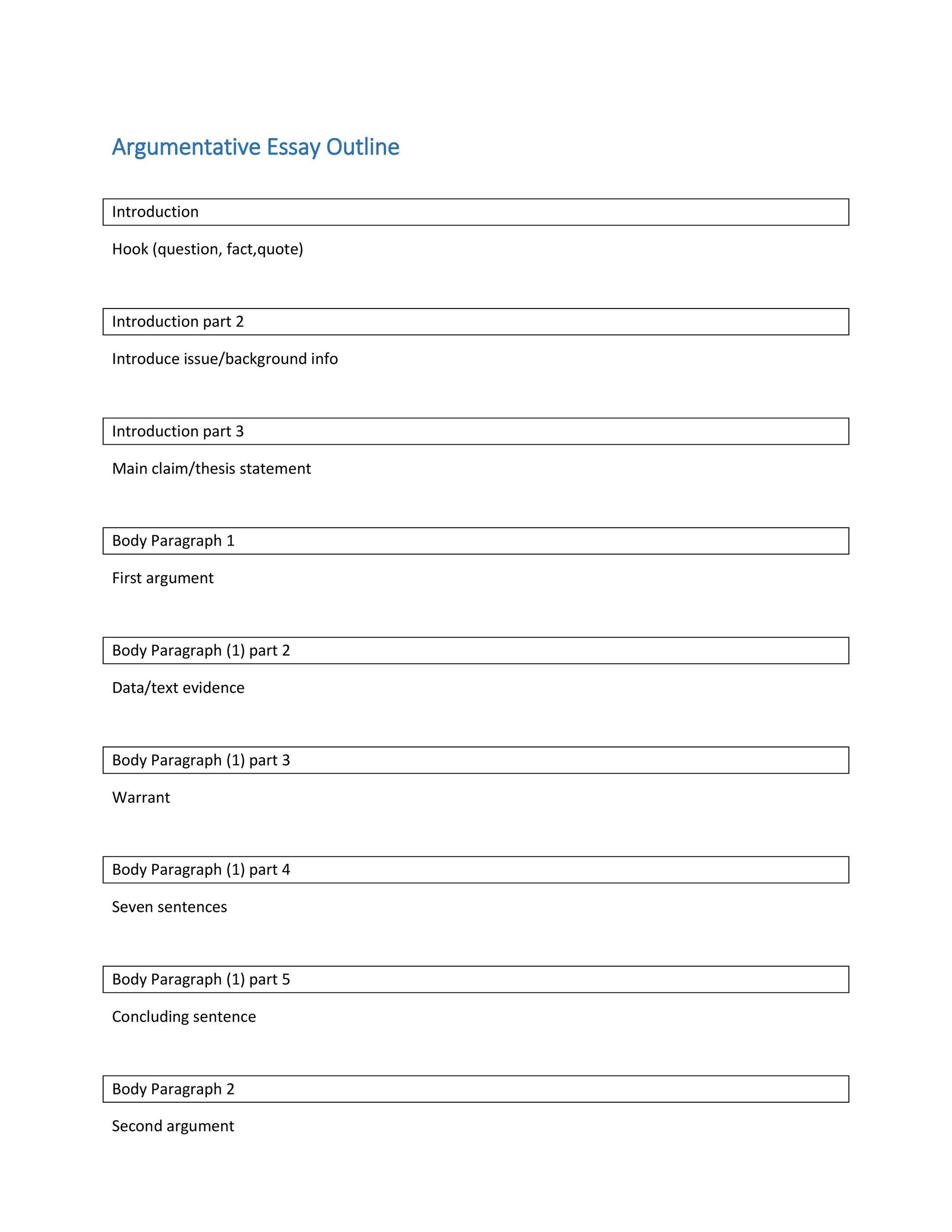
What is the Format of a Five-Paragraph Essay Outline?
A five-paragraph essay outline is a common essay structure used for academic essays. It is particularly useful for shorter essays or beginners who are just starting to develop their writing skills. Many high school students or first-year college students benefit from following this structure.
The format consists of five paragraphs, as the name suggests – an introduction, three body paragraphs, and a conclusion.
- Introduction In the introduction of a five-paragraph essay outline, writers should begin with an attention-grabbing hook to capture the reader’s interest. This can be achieved through a relevant anecdote, a rhetorical question, or a shocking statistic. This helps to immediately capture the reader’s attention and begin the essay strong. Next, provide some background information on the topic and end the introduction with a clear thesis statement that encapsulates the main argument of the essay.
- Body Paragraphs The three body paragraphs of a five-paragraph essay outline each focus on a specific supporting point, which aids in the development of the thesis statement. Start each body paragraph with a topic sentence that introduces the main idea of the paragraph. Following the topic sentence, writers should provide evidence, examples, or arguments to support the main point. It is essential to ensure a logical flow between paragraphs and maintain coherence throughout the essay. This can be done through the use of connectives at the start of each body paragraph, such as ‘Firstly,’ ‘Secondly,’ and ‘Furthermore.’
- Conclusion The conclusion of a five-paragraph essay outline restates the thesis statement and summarizes the main points discussed in the body paragraphs. However, it is vital to avoid introducing new information in the conclusion. Instead, writers should provide a thought-provoking final statement or reinforce the significance of the essay topic.
How to Write an Effective Essay Outline
Each writer will have their own unique approach to essay writing, but preparing an essay outline does not require you to reinvent the wheel. You can follow these simple steps to craft an effective, useful, solid outline.
- Read and Understand the Assignment Before beginning the outline, thoroughly read and understand the essay assignment, including any specific guidelines or requirements from the instructor. This will help in determining the length, topic, and structure of the essay. Understanding the assignment in detail also enables you to plan how you will carry out your preliminary research for the essay. Adaquete reading and preparation also helps you to establish the purpose of your essay, which will determine which essay outline template will work best for you.
- Brainstorm and Organize Ideas Start with brainstorming ideas related to the topic. Here, you should establish the key points of the essay based on your research. Once ideas are generated, you can organize them into meaningful categories or subtopics. In an argumentative essay outline, for example, you will need to compare and contrast ideas. By placing all the main points into categories in an organized manner, you can create a logical flow within the essay, making it more engaging for the reader.
- Choose an Appropriate Outline Format Decide on the outline format that best suits the specific essay requirements. Depending on the complexity of the topic, your essay may be formatted differently. An expository essay will differ from a research paper, for example, so be clear on which outline will work for you. It is also essential to decide on the number of main points to be included based on the required length of the essay. Sometimes it is best to discuss fewer points in greater detail, particularly for a literary analysis or narrative essay.
- Develop Thesis Statement and Main Arguments Craft a strong and clear thesis statement that encapsulates the main argument or claim of the essay. Then, determine the main arguments or supporting points that will be discussed in the body paragraphs.
- Organize Supporting Points and Supporting Evidence Arrange the main arguments in a logical order, keeping in mind the flow of ideas. Ensure that each supporting point is backed up by sufficient evidence or reasoning to strengthen the overall argument. This will also help you to write a strong conclusion to complete your essay.
- Review and Revise After creating the initial essay outline, review and revise it to ensure coherence, logical flow, and adherence to the assignment requirements. Make necessary adjustments and rearrange the outline if needed. Then, you can start writing your essay by following the outline.
Free Essay Outlines
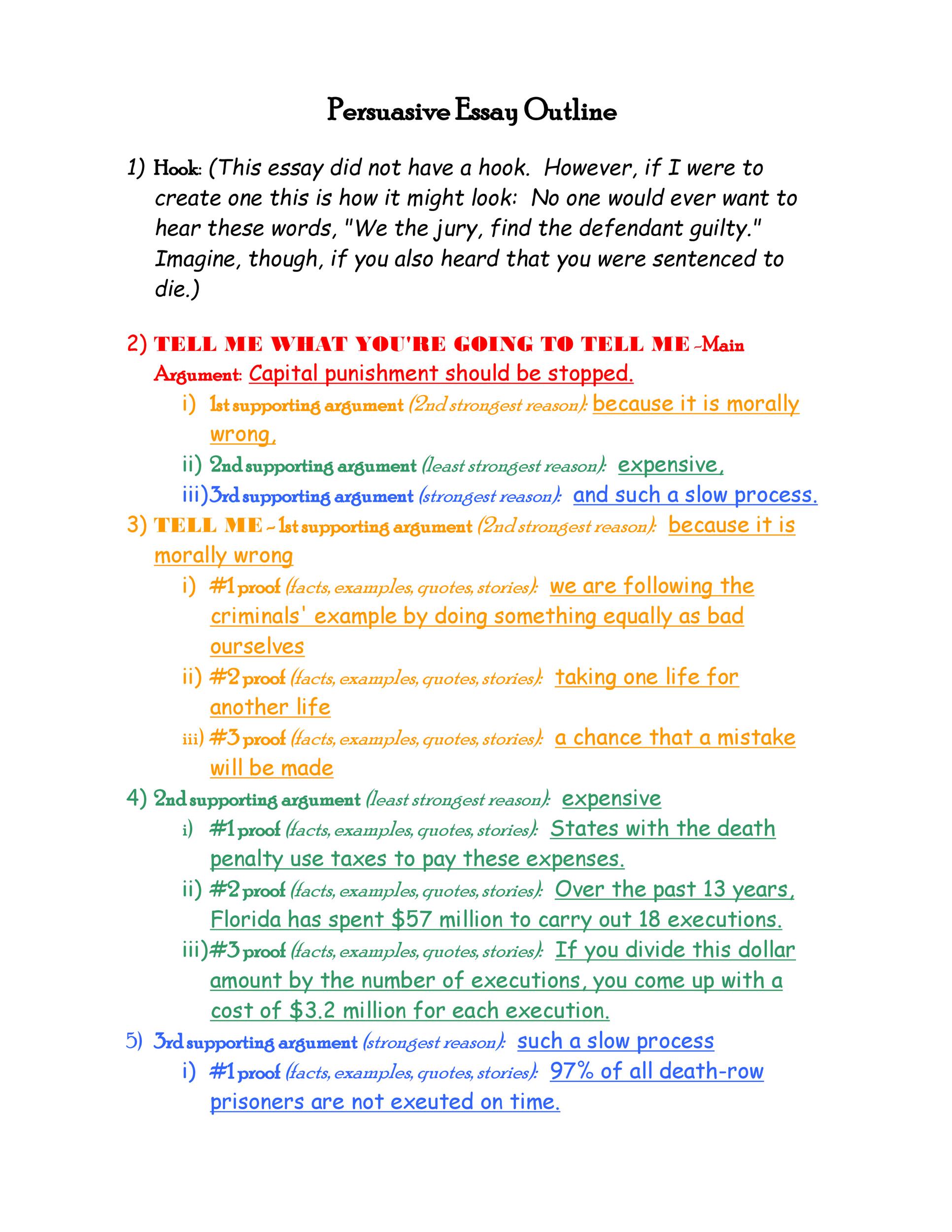
Create an Effective Outline Using an Essay Outline Template
Creating an essay outline is a crucial step in the writing process that should not be overlooked. Whether it’s an argumentative essay outline, a literary analysis essay outline, or a persuasive essay outline, an essay outline template can help you to structure and organize your points in a thoughtful and clear way.
By structuring an essay outline effectively, using the appropriate format for a five-paragraph essay, and following the steps to write an essay outline, writers can ensure a well-organized, coherent, and compelling essay. Utilizing an essay outline template not only enhances the writing quality but also saves time and effort in the long run.
More Templates

Spelling Test Templates

All About Me Templates

Frayer Model Templates

Attendance Sheet Templates

Table of Contents Templates

Literature Review Templates

How to Write an Essay Outline

Have you ever tried writing an essay without an outline? If you have, chances are your ideas went all over the place even though you started out with a specific goal in mind. So when your professor reads the paper, they won’t know what points you’re trying to make or how those points support your thesis statement. If they can’t understand what they’re reading, there’s no way they’ll grade it an A+.
That’s why you should have an essay outline to organize your research or opinions in a way that makes sense for readers. An essay outline helps you structure your writing in a logical flow to get your ideas across more effectively, which also improves your overall writing quality . As such, it also ensures that you don’t accidentally leave out the most critical points you want to convey.
If you’re reading this, you probably don’t know how to write an outline for an essay (yet) or you want to get better at it. That’s exactly what this guide will help you with. You’ll discover what goes into an essay outline and how you can write one for your next paper. Let’s get started.
What is an outline?
An outline is an organization tool that helps authors plan their writing before they start. In other words, it’s a roadmap or a blueprint of your paper. It acts as the foundation of your piece, listing out the main ideas in a logical structure that flows well. Having a topical outline in place also makes it easier to remember all the points you need to form a strong argument or support your opinions.
Although an essay outline isn’t mandatory, it helps you get the job done faster and more easily. When you start writing without a proper plan in mind, however, there could be a lot of restructuring and rewriting. This not only takes time but can be mentally taxing, and you can’t afford that especially when you have other classes to catch up with.
Writing an essay outline involves a few steps – preparation, structuring, and organization. Since this can be a lot of work, it’s best to learn from a writing tutor who will guide you through the entire process and give you hands-on training. That doesn’t mean it’s impossible to learn it on your own, and this guide will give you all the basic ideas you need to cover when creating an outline.
Key elements of an essay outline
Regardless of what type of essay you’re writing, a formal essay outline typically has three essential elements – the introduction, the body, and the conclusion. Let’s take a closer look at each of these components:
The introduction
This is the section where you’ll introduce readers to your topic and describe why you’re writing about it. It needs to be relevant and attention-grabbing. When writing a college research paper outline, be sure to mention the topic and the thesis statement in your introduction.
Starting your outline with a thesis statement will give you a better sense of how to support the ideas and arguments you present in the body.
This is the section that will contain the most information and it’s where you’ll present ideas and arguments to support your thesis. It should have a minimum of three paragraphs and your outline should touch on each of them.
For each paragraph, note the topic or idea you’ll be discussing. Don’t forget to include the supporting evidence such as data, examples, expert opinions, and facts you plan to use for each paragraph.
The conclusion
This is the section where you wrap up the essay and remind readers about the points you were trying to make. Start by paraphrasing your thesis statement and summarize the purpose of your paper.
Outline formatting
In general, most formal essay outlines use a linear formatting style. This involves ranking your points or arguments in order of importance. So for example, you’ll start by discussing the most important point at the top of your essay body and then gradually move downward.
Considering all these elements, your essay outline will typically look like this:
3 Questions to ask before creating an outline
Before you’re ready to create your essay outline, ask yourself the following questions so you can start with a strong direction. Having all this information in place will make it easier to put together your outline:

1: What’s your goal?
What’s the purpose of writing this paper? Perhaps you want to inform your readers about a specific topic or maybe you want to persuade them to accept your argument. Identifying your goal will help you form a strong thesis statement as well.
2: Who will read it?
For whom are you writing your essay? Yes, you’ll consider writing for a professor when preparing a college research paper outline, but they aren’t your only target audience. Perhaps you’re writing for your classmates and peers, or you’re writing for experts in your field.
If you’re writing a college application essay, for instance, your target audience will be the members of the admissions committee. This means you should be writing for students, staff, and professors alike.
Identifying your target audience will help you understand how to form convincing arguments while considering their knowledge and points of view.
3: What’s your thesis statement?
Now based on the goal of your essay, come up with a strong thesis statement that details your argument and draws in the readers.
Structuring your outline
Once you have a goal and a thesis statement ready, it’s time to structure your essay outline. You can either use an alphanumeric outline structure like we’ve done in the above example, or you can also go for a decimal structure depending on what’s clearer to you.
Alphanumeric format:
Decimal format:
Remember, this isn’t your full essay yet so feel free to briefly outline your ideas in fragmented sentences. However, a college research paper outline will most likely need complete sentences if your professor is going to review it. This will help them understand the ideas and arguments you plan on presenting in your essay.
Putting this all together
Now let’s get to the main event – organizing your essay outline. Follow the topical outline structure of your choice and begin by outlining the introduction. In a sentence, describe the topic you’re writing about. Then follow up with your thesis statement.
You might also want to include an essay hook to make your paper even more enticing for readers. An essay hook is the opening sentence of your introduction, which instantly draws in readers and makes them want to read the entire piece. It could be anything from a relevant quote or a common misconception to an anecdote or a personal story.
Next, outline the body of your essay by noting down the topic or argument for each paragraph. Include the supporting evidence you plan on using such as stats , facts, examples, and expert opinions. Don’t forget to mention how the evidence ties in with the topic and thesis statement.
It will help to include a transition sentence in each paragraph so you can quickly structure your arguments in a logical flow. When you add more details to your essay outline, you’ll find it much easier to organize all the info as you write.
Finally, end it with an outline of your essay conclusion. Make sure you restate your thesis statement to remind your readers of your argument. Then follow up with a concluding statement to validate your thesis and propose any solution or plan to address the issue discussed in your essay.
Outline examples for different types of essays
While it’s helpful to read articles that tell you what to do and how to do it, working with a personal English tutor can give you a much more practical experience in writing essay outlines. Another excellent solution is to learn from example . So we’ve put together outline examples for the most popular types of essays:
Argumentative essay outline example
An argumentative essay, also known as a persuasive essay, involves using logical arguments to support your opinion and persuade readers. This type of persuasive writing will require solid evidence to back up your theory or argument such as facts, research, and examples.
Narrative essay outline example
A narrative essay is a form of descriptive writing where you narrate a story based on your personal experience or point of view. This is the easiest type of essay because it doesn’t require any research or supporting evidence. However, the most challenging part is providing specific and sensory details that would help readers understand your point of view.
Research essay outline example
A research essay is a form of academic writing which involves analyzing the works of other people on a certain topic and build on them using your own opinions or ideas. This is the most common type of essay you’ll have to write as a grad or post-grad student. It can be challenging as it requires plenty of research, coupled with original ideas and critical thinking.
Get ready to write sensational essays
All the tips and examples we’ve provided above will help you understand how and where to begin your essay writing process . It all starts with a good essay outline to organize your thoughts and structure your writing flow. Otherwise, you’ll end up losing your train of thought while you’re in the middle of writing. So make the most of our guide to develop your essay and outline writing skills.

Jacqueline Zote is a copywriter with a passion for all things relating to the English language. Her interests range from pop culture and mythology to social activism. Her short fiction has appeared in anthologies published by HarperCollins Publishers and Zubaan Books.
9 Easy Ways to Improve Your Writing Skills
Fundamentals of french grammar, related articles, what kind of writing tutor do i actually..., writer’s block is real, and here’s how you..., how to self-edit: 12 steps to better writing, the keys to writing consistently for any assignment, watch: get ready for high school free lesson..., 18 best writing resources for students, how to write a thesis statement, the law school hopeful’s guide to confident lsat..., 19 common grammar mistakes (and how to avoid..., how to write a research paper: 9 steps....
- PRO Courses Guides New Tech Help Pro Expert Videos About wikiHow Pro Upgrade Sign In
- EDIT Edit this Article
- EXPLORE Tech Help Pro About Us Random Article Quizzes Request a New Article Community Dashboard This Or That Game Popular Categories Arts and Entertainment Artwork Books Movies Computers and Electronics Computers Phone Skills Technology Hacks Health Men's Health Mental Health Women's Health Relationships Dating Love Relationship Issues Hobbies and Crafts Crafts Drawing Games Education & Communication Communication Skills Personal Development Studying Personal Care and Style Fashion Hair Care Personal Hygiene Youth Personal Care School Stuff Dating All Categories Arts and Entertainment Finance and Business Home and Garden Relationship Quizzes Cars & Other Vehicles Food and Entertaining Personal Care and Style Sports and Fitness Computers and Electronics Health Pets and Animals Travel Education & Communication Hobbies and Crafts Philosophy and Religion Work World Family Life Holidays and Traditions Relationships Youth
- Browse Articles
- Learn Something New
- Quizzes Hot
- This Or That Game
- Train Your Brain
- Explore More
- Support wikiHow
- About wikiHow
- Log in / Sign up
- Education and Communications
- College University and Postgraduate
- Academic Writing
How to Write a Short Essay
Last Updated: January 17, 2024 Fact Checked
This article was co-authored by Christopher Taylor, PhD . Christopher Taylor is an Adjunct Assistant Professor of English at Austin Community College in Texas. He received his PhD in English Literature and Medieval Studies from the University of Texas at Austin in 2014. There are 12 references cited in this article, which can be found at the bottom of the page. This article has been fact-checked, ensuring the accuracy of any cited facts and confirming the authority of its sources. This article has been viewed 116,241 times.
Essay writing is a common assignment in high school or college courses, especially within the humanities. You’ll also be asked to write essays for college admissions and scholarships. In a short essay (250-500 words), you will need to provide an introduction with a thesis, a body, and a conclusion, as you would with a longer essay. Depending on the essay requirements, you may also need to do academic or online research to find sources to back up your claims.
Picking a Topic and Gathering Research
- If you have any questions about the topic, ask your instructor. If your essay doesn't respond to the prompt, you likely won't receive full credit.

- If you're writing an essay for an in-class test or for an application, tailor the essay to the given prompt and topic. Quickly brainstorm a few ideas; for example, think of positive things you can say about yourself for a college-entrance essay.
- For example, the topic “depression in American literature” is far too broad. Narrow down your topic to something like “Willie Loman’s depression in Death of a Salesman .”
- Or, you could write about a narrow topic like “the increase in the USA’s national debt in the 1950s” rather than a broad topic like “the American economy in the 20th century.”

- Depending on the field in which you’re writing the essay—e.g., hard sciences, sociology, humanities, etc.—your instructor will direct you towards appropriate databases. For example, if you’re writing a high-school or college-level essay for your English class, visit online literary databases like JSTOR, LION, and the MLA Bibliography.
- If you're writing the essay for a college or graduate-school application, it's unlikely that you'll need to include any secondary sources.
- If you're writing a timed or in-class essay, you may not be able to find research articles. But, still do draw information from texts and sources you've studied both in and out of class, and build from points made in any provided reading passages.

- If you’re writing about current events or journalism topics, read articles from well-known news sites like CNN or the BBC.
- Avoid citing unreliable websites like blogs or any sites that have a clear bias about the topic they’re reporting on.
Composing the Essay

- If you write the essay without outlining, the essay will be poorly organized.

- This thesis statement is far too weak: “ Death of a Salesman shows the difficulty of living in America after WWII.”
- Instead, hone your thesis to something like: “Arthur Miller uses Death of a Salesman to show that the American Dream is materialist and impractical.”

- So, avoid beginning the paragraph by writing something like, “Since the beginning of time, all people have been consumed with the desire for their father’s approval.”
- Instead, write something like, “In the play Death of a Salesman , Willie Loman’s sons compete for their father’s approval through various masculine displays."
- Then, you can say, "To examine this topic, I will perform a close reading of several key passages of the play and present analyses by noted Arthur Miller scholars."

- In a short essay, the conclusion should do nothing more than briefly restate your main claim and remind readers of the evidence you provided.

- So, take the example about Death of a Salesman . The first body paragraph could discuss the ways in which Willie’s sons try to impress him.
- The second body paragraph could dive into Willie’s hopelessness and despair, and the third paragraph could discuss how Miller uses his characters to show the flaws in their understanding of the American Dream.

- Always cite your sources so you avoid charges of plagiarism. Check with your instructor (or the essay prompt) and find out what citation style you should use.
- For example, if you’re summarizing the inflation of the American dollar during the 1930s, provide 2 or 3 years and inflation-rate percentages. Don’t provide a full-paragraph summary of the economic decline.
- If you're writing an in-class essay and don't have time to perform any research, you don't need to incorporate outside sources. But, it will impress your teacher if you quote from a reading passage or bring up pertinent knowledge you may have gained during the class.

- If no one agrees to read the essay, read over your own first draft and look for errors or spots where you could clarify your meaning. Reading the essay out loud often helps, as you’ll be able to hear sentences that aren’t quite coherent.
- This step does not apply to essays written during a timed or in-class exam, as you won't be able to ask peers to read your work.

- It’s always a mistake to submit an unrevised first draft, whether for a grade, for admissions, or for a scholarship essay.
- However, if you're writing an essay for a timed exam, it's okay if you don't have enough time to combine multiple drafts before the time runs out.
Condensing Your Essay

- So, if you’re writing about Death of a Salesman , an article about symbolism in Arthur Miller’s plays would be useful. But, an article about the average cost of Midwestern hotels in the 1940s would be irrelevant.
- If you’re writing a scholarship essay, double-check the instructions to clarify what types of sources you’re allowed to use.

- A common cliche you might find in an essay is a statement like, "I'm the hardest working student at my school."
- For example, this sentence is too verbose: “I have been a relentlessly stellar student throughout my entire high school career since I am a seriously dedicated reader and thoroughly apply myself to every assignment I receive in class.”
- Shortened, it could read: “I was a stellar student throughout my high school career since I was a dedicated reader and applied myself to every assignment I received.”

- Avoid writing something like, “Willie Loman can be seen as having achieved little through his life because he is not respected by his sons and is not valued by his co-workers.”
- Instead, write, “Arthur Miller shows readers that Willie’s life accomplishments have amounted to little. Willie’s sons do not look up to him, and his co-workers treat him without respect.”

- For example, if you’re trying to prove that WWII pulled the USA out of the Great Depression, focus strictly on an economic argument.
- Avoid bringing in other, less convincing topics. For example, don’t dedicate a paragraph to discussing how much it cost the USA to build fighter jets in 1944.
Short Essay Template and Example

Expert Q&A
- When composing the text of your essay, resist the temptation to pull words from a thesaurus in an attempt to sound academic or intelligent. Thanks Helpful 1 Not Helpful 0
- If your high school or college has an online or in-person writing center, schedule an appointment. Taking advantage of this type of service can improve your essay and help you recognize structural or grammatical problems you would not have noticed otherwise. Thanks Helpful 1 Not Helpful 0

You Might Also Like

- ↑ https://owl.purdue.edu/owl/general_writing/common_writing_assignments/research_papers/choosing_a_topic.html
- ↑ https://monroecollege.libguides.com/c.php?g=589208&p=4072926
- ↑ https://www.utep.edu/extendeduniversity/utepconnect/blog/march-2017/4-ways-to-differentiate-a-good-source-from-a-bad-source.html
- ↑ https://www.grammarly.com/blog/essay-outline/
- ↑ https://writingcenter.unc.edu/tips-and-tools/thesis-statements/
- ↑ https://libguides.newcastle.edu.au/how-to-write-an-essay/essay-introduction
- ↑ https://lsa.umich.edu/sweetland/undergraduates/writing-guides/how-do-i-write-an-intro--conclusion----body-paragraph.html
- ↑ https://mlpp.pressbooks.pub/writingsuccess/chapter/8-3-drafting/
- ↑ https://www.trentu.ca/academicskills/how-guides/how-write-university/how-approach-any-assignment/writing-english-essay/using-secondary
- ↑ https://patch.com/michigan/berkley/bp--how-to-shorten-your-college-essay-without-ruining-it
- ↑ https://writing.wisc.edu/handbook/style/ccs_activevoice/
- ↑ https://wordcounter.net/blog/2016/01/26/101025_how-to-reduce-essay-word-count.html
About This Article

- Send fan mail to authors
Reader Success Stories
D. L. Smith
Sep 9, 2019
Did this article help you?
Aug 15, 2023

Featured Articles

Trending Articles

Watch Articles

- Terms of Use
- Privacy Policy
- Do Not Sell or Share My Info
- Not Selling Info
wikiHow Tech Help Pro:
Level up your tech skills and stay ahead of the curve
WTO / Guides / 35 Free Essay Outline Templates | How to Write (9 Types)
35 Free Essay Outline Templates | How to Write (9 Types)
Creating an effective essay outline is fundamental to the writing process. An appropriately crafted outline can help you create a coherent, well-planned essay. Whether you build your structure for the essay or you use a template, this first step is the key to excellent writing.
In this article, you’ll learn what an outline is and how to make the most of it.
What is an Essay Outline?
It is the skeleton of your final paper. It should contain all the main ideas and concepts included and demonstrate them. A proper outline will easily convey the main argument and have a coherent flow connecting ideas.
You’ll often be asked to submit an outline before starting, but even if not, it’s essential to the writing process as it will keep your thoughts organized and your essay clear.
Why is It Important?
While it’s entirely possible to write your essay without an outline, it won’t be nearly as structured and coherent without one. Highly effective writing takes considerable planning. After doing all the research required, you should find the best way to connect all this information to be clear and readable.
An outline will also help keep you organized as you’re writing, making the process easier for you. You won’t need to worry about what comes next as you write. It already has the main ideas organized for you, so all you need to do is put those arguments into words.
Finally, an outline can be helpful to make sure that you don’t miss any key arguments. It’s easy to get caught up in typing your essay as quickly as possible, so you’ll be guaranteed not to skip anything important by having an outline.
Outline Templates
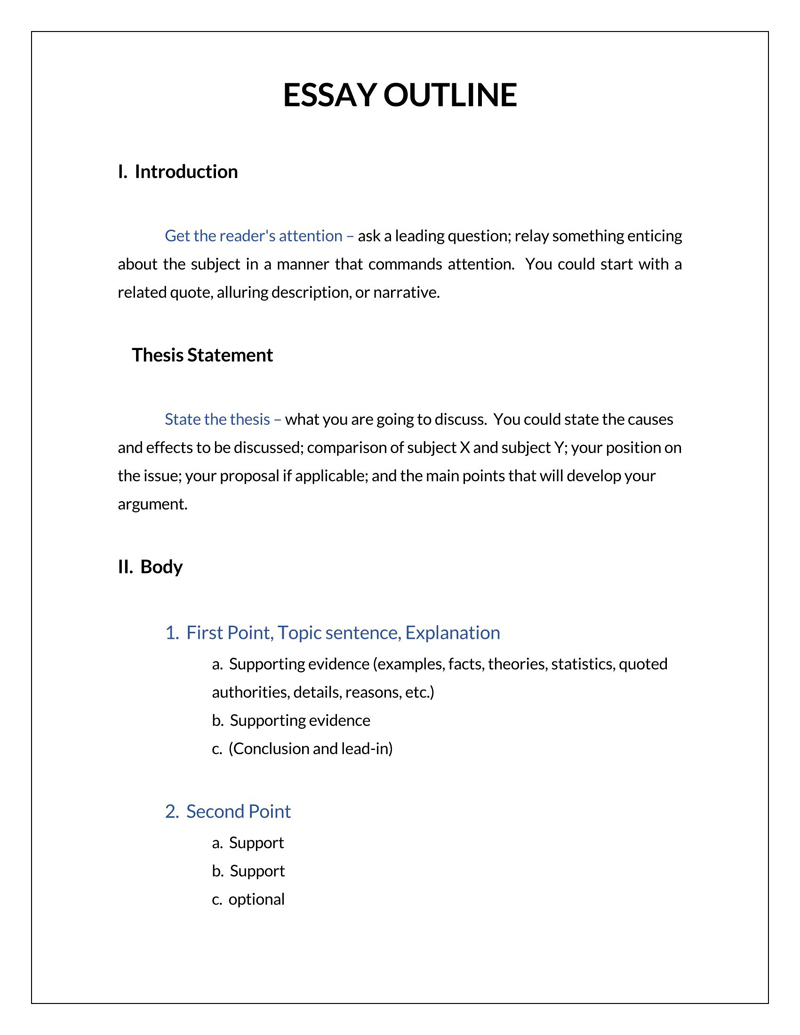
Pre-Writing Considerations
Before jumping into drafting your first outline, there are some key ideas you should keep in mind first. A strong outline is all about appropriate planning and structure, so before putting pen to paper, here are some pre-considerations:
Read your assignment
The very first step is clear, that is read the assignment carefully. A big step in the writing process is making sure that you’re writing something with purpose, and, in this case, the purpose may be to follow instructions. For example, if you need to make a persuasive essay , the structure will differ from that of a research essay.
Reading the assignment first will ensure that you’re on the right track and understand what the final product should look like.
Answer the question
After reading the assignment, you should make sure you have a clear answer to the question. Your thesis statement should be the main argument for your essay and answer whatever question has been presented.
For example, when writing a persuasive essay about raising the minimum wage, your outline should clearly state your stance. By taking a brief look at your outline, a reader should understand the answer to the prompt and the main arguments you’ll be using to support your opinion.
Identify the audience
The following critical step to appropriate essay writing is to identify the audience. Of course, the style and tone of your writing will be very different depending on who your target reader is. For example, if your audience will be your peers, you may use a more casual tone than if your target reader is an academic expert.
By identifying the audience, you’ll make sure that your word choice is practical, your register is appropriate, and your argument resonates with the reader.
Organize your material
The next step is to collect your arguments and organize them coherently to create an outline. You may have already formed your ideas, but it’s okay if you haven’t created a strongly worded-argument yet. So here, the goal is to organize your thoughts and your sources so that you can refer back to them when you’re writing:
Create categories
You should go back through all the research and ideas you’ve considered and separate them into different categories in the outline. In a persuasive essay, the different categories may be the separate points to your argument and the information that backs them up.
All of these different categories should be able to be connected back to your thesis statement since it’s the main idea. Depending on the essay’s length, you could have two or three principal arguments connecting to your thesis statement. Typically, you would want a minimum of one paragraph dedicated to each point.
Afterward, once you have all of these points written down on your outline, take a moment to step back. Ask yourself if everything flows correctly or if there is any repetition. Likewise, make sure that all key arguments you want are represented in this structure.
Order of information
Once you have all the categories presented in the outline, you’ll want to work on the flow of the essay. While you should always have a clear introduction and conclusion, the body can come in different forms.
The best way to do this is by considering how the different categories connect in the outline. If point A leads into point B naturally, then point A should come first. If there is a clear starting point to your essay, you should begin there. It would be best if you typically considered starting with your strongest argument to entice the reader and keep them interested.
State your thesis
Finally, you’ll want to craft your thesis statement once the outline structure is determined. This statement will be exactly what appears in your essay, and so, it should be robust and well thought out.
The thesis statement should state your main argument and the different points you will make in your essay. In short, your thesis statement should be a highly condensed version of the entire paper.
How to Structure an Outline?
While every essay will be slightly different, a generalized template can be followed when starting. For example, consistent with the concepts mentioned above, the following example could be a potential outline for a persuasive essay on the controversial topic of raising the minimum wage.:
- Introduction: Minimum wage and how it affects the population.
- Hook : People working full-time cannot afford to live a luxurious life.
- Background : Low wages affect people’s lives by impeding their ability to grow wealth, take care of their basic needs, and enjoy a dignified lifestyle.
- Thesis statement : “Increasing the minimum wage would positively impact society as it has not kept up with inflation over the years. It would reduce poverty and result in a stronger economy.”
- Topic 1: The minimum wage has remained lower over the years and has not increased proportionally with the cost of living.
- Topic 2: Increasing minimum wage would help reduce poverty by allowing people to pay for their basic needs and have money to save.
- Topic 3: As more people would have money to spend on goods and services besides basic amenities, the economy would improve.
- Conclusion: Increasing the minimum wage would be largely beneficial for the entire population by allowing them to cover their basic needs, grow their wealth, and spend money at local businesses.
- Summary : The current minimum wage is insufficient as the cost of living far exceeds a full-time worker’s financial capabilities. It should be raised in order to meet the basic needs of the population.
- Importance of topic : The purpose of a minimum wage is to guarantee everyone’s right to have their basic needs fulfilled, therefore the minimum wage should be at a level where it reflects that.
- Strong closing statement : The current minimum wage does not meet its own requirements by definition, therefore raising it is the only option.
Each section has been discussed below to understand the above example outline better:
Introduction
The introduction will address the topic at hand. As a writer, it is your chance to entice the reader and have them interested in what they are about to read. The introduction of outline will comprise a hook, the background, and the thesis statement. Therefore, the introduction should be as catchy as possible and specifically aimed at your target reader.
The hook will be the first statement of the introduction and should be something that catches the reader’s attention. This can often come in the form of a statistic or an otherwise powerful statement.
Background
After the hook, the writer should give some background information to the problem at hand. In this case, the writer can explain the current low minimum wage problem and how it poorly affects the population. This type of argument in the background information will further strengthen the author’s argument.
Thesis statement
Traditionally, the last sentence of the introduction will be the thesis. Doing so makes it incredibly clear to the reader what will be included in the rest of the essay. This way, the reader is prepared for what comes ahead and knows exactly what the author will argue. This allows for a clear and coherent argument at the core of every effective essay.
The body comprises the main arguments that support your thesis statement. In this example outline, three different points were given to connect to the thesis and persuade the reader to take the author’s stance.
A minimum of one paragraph should be dedicated to each of the three body topics. Depending on the desired length, this could be increased. Regardless, the three ideas should be independent of one another but should still naturally flow from one idea to the next. This allows for coherency and improved essay structure and can be done through transition sentences.
Within the conclusion, you should be able to summarize everything that has been said up to this point and restate your main argument firmly.
The start of conclusion will summarize three-body topics as indicated in the example outline above. This allows the reader to understand that the essay is coming to a natural conclusion and improves the fluidity of reading.
Importance of topic
In parallel with the introduction, it is often advisable to restate the importance of the topic at hand. In this case, to restate how low wages negatively affect the population. Depending on your audience, this could be done through pure statistics or a more emotionally-based point.
Strong closing statement
Finally, a powerful statement that ends the essay should be placed at the end of the outline. It should restate the importance of the thesis statement and persuasively mention your argument.
Outline Format
Depending on the type of essay you’re writing and your personal preference, there are a variety of outline formats you can use.
Here are just a couple:
Alphanumeric format of outline
This is by far the most common of the formats. It allows for a clear representation of each topic you’ll be discussing within your essay. This type of outline will use numbers to represent the main sections, while the subsections will be represented by letters, or vice-versa.
Decimal format of an outline
A decimal format is another standard outline structure. Ultimately, it is pretty similar to the alphanumeric format, but some people prefer this style as it may seem more evident. Both are perfectly acceptable as long as you use them to give your essay structure.
Following are a few more outlines for your ease:
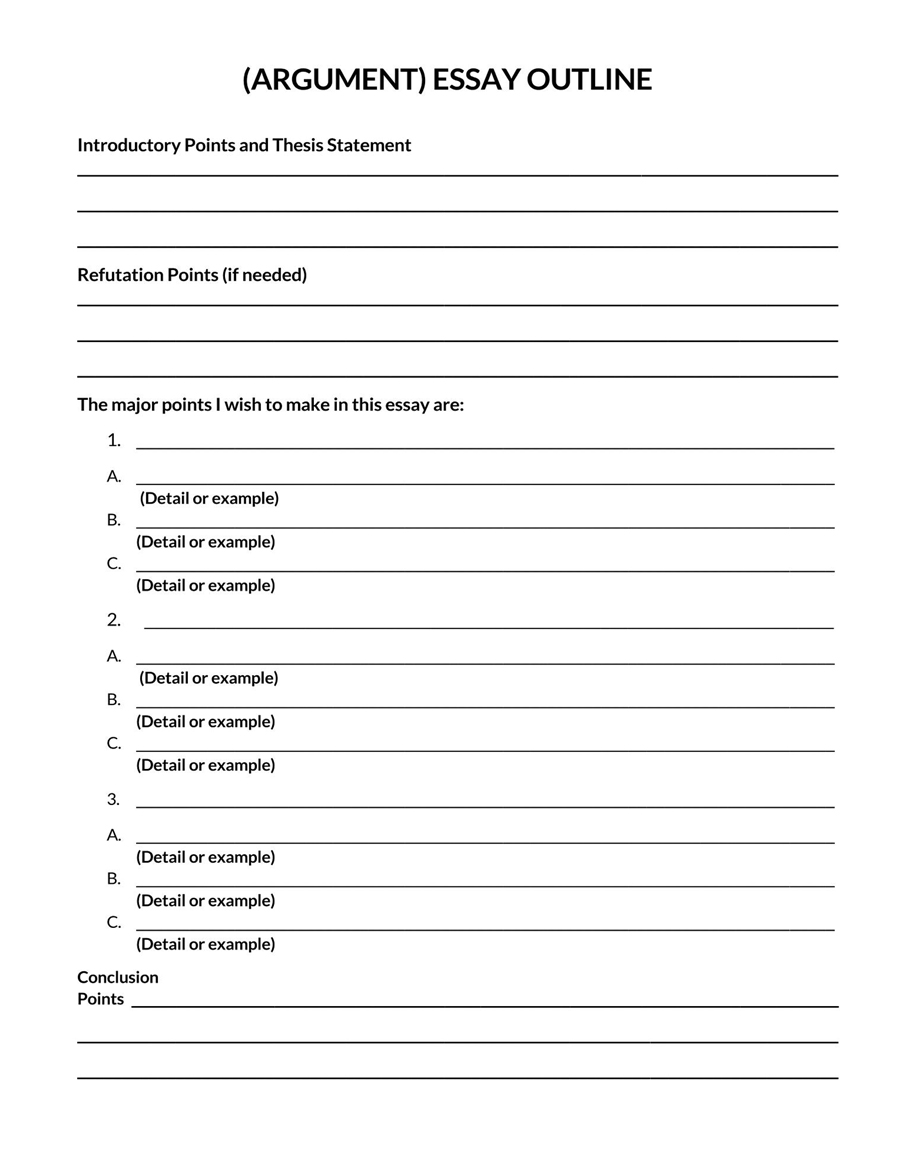
Download: Microsoft Word (.docx)
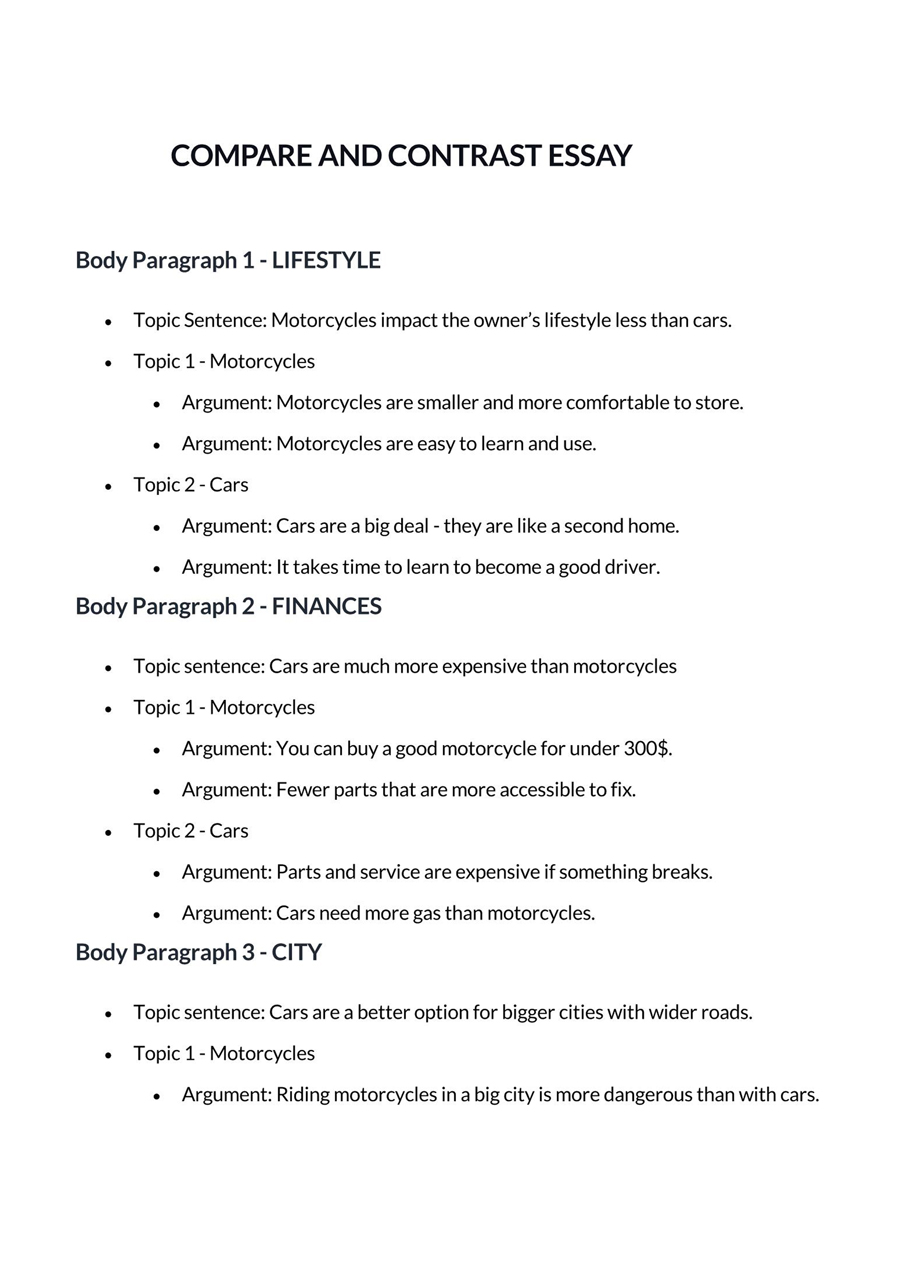
Frequently Asked Questions
You should start writing your outline before beginning to write your essay. In fact, your professor may even ask to see the outline earlier in an academic environment. Although, even when it is not required, an outline can be beneficial for you to smooth out the writing process. You can always use a template if you’re lost or don’t know where to start.
Some supervisors have different guidelines that describe whether or not complete sentences are necessary. It won’t be indispensable as long as your ideas are clearly expressed in most cases. If you’re writing the outline for yourself solely, you can decide. But ultimately, the outline is there to help you during your writing process, so choose whatever you find most comfortable.
Ideally, you should follow your outline as much as possible. But, of course, as you write your essay, you may discover an alternative argument or structure that you find better. If that’s the case, make sure you take the time to consider whether or not it truly is beneficial to the overall essay.
About This Article

Was this helpful?
Great! Tell us more about your experience
Not up to par help us fix it, keep reading.

Education , Guides

Argumentative Essay Outline Format [12 Best Examples]

7 Best Research Paper Outline Examples (Guide + Tips)

How to Write a Descriptive Essay (12 Best Examples)

How to Write a Narrative Essay (12 Best Examples)

How to Write an Expository Essay? (16 Best Examples)

12 Free Kindergarten Newsletter Templates

12 Perfect Examples of Salutatorian Speech

12 Free Yes No Flowchart Templates (PowerPoint)

Army Counseling Examples – Event, Performance, Growth
Thank you for your feedback.
Your Voice, Our Progress. Your feedback matters a lot to us.
Have a language expert improve your writing
Run a free plagiarism check in 10 minutes, generate accurate citations for free.
- Knowledge Base
- Research paper
How to Create a Structured Research Paper Outline | Example
Published on August 7, 2022 by Courtney Gahan . Revised on August 15, 2023.

A research paper outline is a useful tool to aid in the writing process , providing a structure to follow with all information to be included in the paper clearly organized.
A quality outline can make writing your research paper more efficient by helping to:
- Organize your thoughts
- Understand the flow of information and how ideas are related
- Ensure nothing is forgotten
A research paper outline can also give your teacher an early idea of the final product.
Instantly correct all language mistakes in your text
Upload your document to correct all your mistakes in minutes

Table of contents
Research paper outline example, how to write a research paper outline, formatting your research paper outline, language in research paper outlines.
- Definition of measles
- Rise in cases in recent years in places the disease was previously eliminated or had very low rates of infection
- Figures: Number of cases per year on average, number in recent years. Relate to immunization
- Symptoms and timeframes of disease
- Risk of fatality, including statistics
- How measles is spread
- Immunization procedures in different regions
- Different regions, focusing on the arguments from those against immunization
- Immunization figures in affected regions
- High number of cases in non-immunizing regions
- Illnesses that can result from measles virus
- Fatal cases of other illnesses after patient contracted measles
- Summary of arguments of different groups
- Summary of figures and relationship with recent immunization debate
- Which side of the argument appears to be correct?
Receive feedback on language, structure, and formatting
Professional editors proofread and edit your paper by focusing on:
- Academic style
- Vague sentences
- Style consistency
See an example

Follow these steps to start your research paper outline:
- Decide on the subject of the paper
- Write down all the ideas you want to include or discuss
- Organize related ideas into sub-groups
- Arrange your ideas into a hierarchy: What should the reader learn first? What is most important? Which idea will help end your paper most effectively?
- Create headings and subheadings that are effective
- Format the outline in either alphanumeric, full-sentence or decimal format
There are three different kinds of research paper outline: alphanumeric, full-sentence and decimal outlines. The differences relate to formatting and style of writing.
- Alphanumeric
- Full-sentence
An alphanumeric outline is most commonly used. It uses Roman numerals, capitalized letters, arabic numerals, lowercase letters to organize the flow of information. Text is written with short notes rather than full sentences.
- Sub-point of sub-point 1
Essentially the same as the alphanumeric outline, but with the text written in full sentences rather than short points.
- Additional sub-point to conclude discussion of point of evidence introduced in point A
A decimal outline is similar in format to the alphanumeric outline, but with a different numbering system: 1, 1.1, 1.2, etc. Text is written as short notes rather than full sentences.
- 1.1.1 Sub-point of first point
- 1.1.2 Sub-point of first point
- 1.2 Second point
To write an effective research paper outline, it is important to pay attention to language. This is especially important if it is one you will show to your teacher or be assessed on.
There are four main considerations: parallelism, coordination, subordination and division.
Parallelism: Be consistent with grammatical form
Parallel structure or parallelism is the repetition of a particular grammatical form within a sentence, or in this case, between points and sub-points. This simply means that if the first point is a verb , the sub-point should also be a verb.
Example of parallelism:
- Include different regions, focusing on the different arguments from those against immunization
Coordination: Be aware of each point’s weight
Your chosen subheadings should hold the same significance as each other, as should all first sub-points, secondary sub-points, and so on.
Example of coordination:
- Include immunization figures in affected regions
- Illnesses that can result from the measles virus
Subordination: Work from general to specific
Subordination refers to the separation of general points from specific. Your main headings should be quite general, and each level of sub-point should become more specific.
Example of subordination:
Division: break information into sub-points.
Your headings should be divided into two or more subsections. There is no limit to how many subsections you can include under each heading, but keep in mind that the information will be structured into a paragraph during the writing stage, so you should not go overboard with the number of sub-points.
Ready to start writing or looking for guidance on a different step in the process? Read our step-by-step guide on how to write a research paper .
Cite this Scribbr article
If you want to cite this source, you can copy and paste the citation or click the “Cite this Scribbr article” button to automatically add the citation to our free Citation Generator.
Gahan, C. (2023, August 15). How to Create a Structured Research Paper Outline | Example. Scribbr. Retrieved June 24, 2024, from https://www.scribbr.com/research-paper/outline/
Is this article helpful?
Courtney Gahan
Other students also liked, research paper format | apa, mla, & chicago templates, writing a research paper introduction | step-by-step guide, writing a research paper conclusion | step-by-step guide, get unlimited documents corrected.
✔ Free APA citation check included ✔ Unlimited document corrections ✔ Specialized in correcting academic texts
- Translators
- Graphic Designers
Please enter the email address you used for your account. Your sign in information will be sent to your email address after it has been verified.
4 Essay Outline Templates That Will Simplify Your Writing Process

Have you ever put together a piece of furniture (or maybe stood by and watched someone else do it)? The task was made a lot easier thanks to the instructions that came in the box. The piece of furniture didn't exactly build itself just because it came with instructions, but without these instructions the task would be nearly impossible to complete.
You can think of an outline for your essay kind of like a set of instructions. Although you still have to put in quite a bit of effort while you're building/writing it, the instructions will help guide you through the entire process so that you don't have to go in there completely blind.
An essay outline is especially helpful for those who are novice writers, but even the old pros use outlines. The prolific William Faulkner was known to use an outline, and he wrote a timeline out for his novel A Fable on his office walls , which can be still seen on display at his home Rowan Oak in Oxford, Mississippi. Now we're not advocating for anyone to write on their walls (sorry to all the moms out there!), but his method was effective because he was able to visualize his timeline and organize his writing around it.
When you are assigned an essay, you might be tempted to wait until the last minute and just write something out really quickly. But without a concrete plan or knowing what it is that you're going to say, you might find yourself hovering over a computer with a blank page and a blinking cursor in the middle of the night. Nobody wants to be in that position, so let's aim to plan ahead, shall we?
Why you should use an outline for everything you write
Have you ever heard the phrase "great ideas take time"? No amazing writer in the history of the universe just started typing one day and then had his or her writing magically turned into a book. Great writing requires great planning. Even if a writer didn't physically write down her timeline, she had a general idea of what she was going to write about before she started typing. Of course, there is such a thing as being inspired and acting on that inspiration (but let's be honest, your history essay isn't probably going to spark that kind of creativity in you).
So, because we are writing a very structured piece with a somewhat predictable layout, it's always best to use an outline. After you do your required research for your topic, an outline will help you to keep all of the points you want to make organized so that you don't skip any important pieces of information and so you can stay on track.
How do you write an outline?
The beauty of an outline is that no one will be seeing your outline — unless, of course, your teacher is making you turn it in beforehand so that he or she can review it before you turn in your paper. However, even if your teacher is reviewing the outline before you turn in your essay, it's doubtful that he or she will grade too harshly on how you organize your thoughts. The main idea is that your teacher wants to see that you're putting in some thought before you write the essay.
Because there's not as much pressure to make an outline sound "nice" and be grammatically correct, you can get out your thoughts quicker and easier. You can use a piece of scratch paper for an outline and just jot down a few points or you can get really intricate by creating a writing outline on the computer. Whatever way you want to write your outline is fine — just make sure you're doing it. Generally, in an outline you will need to have an idea of what your thesis statement will be, how your body paragraphs will support your thesis statement, and how you are going to wrap everything up in a conclusion at the end.
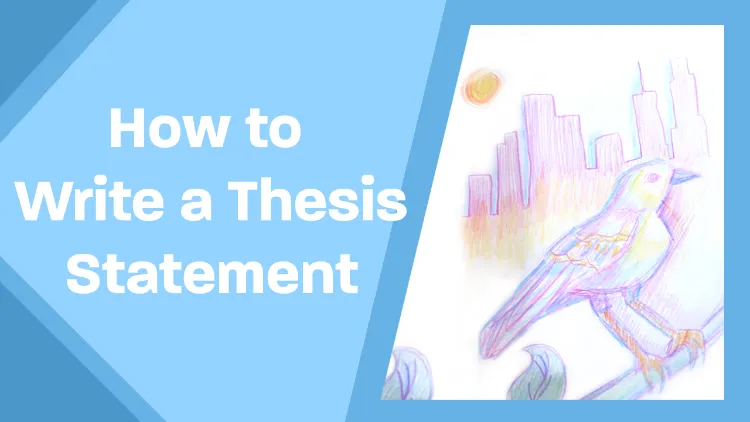
Still a little unsure of how to start? We've provided some examples below of what an outline will look like for a few different types of essays. Remember that these outlines are just samples. They aren't necessarily something set in stone that you can't adapt for your particular assignment or idea.
The argumentative essay
The argumentative essay is as old as writing is. The idea of an argumentative is — you guessed it — to establish an argument and provide evidence of why your claim is correct . You will collect evidence in defense of your argument and evaluate it.
Here is a sample of what an argumentative essay outline might look like:
- General background information about your topic
- Thesis statement
- Supporting fact
- Your response to this claim
- Reiterate arguments made in thesis statement
- Why this essay matters (ideas for future research, why it's especially relevant now, possible applications, etc.)
Expository essay outline
Expository essays often get confused with argumentative essays, but the main difference is that the writer's opinions and emotions are completely left out of an expository essay. The objective of an expository essay is to investigate a topic and present an argument in an unbiased way, but to still arrive at a conclusion. Because of this subtle difference, it's important to have a solid outline to get you started on your writing.
- The presentation of the topic
- Your thesis statement
- Supporting evidence
- Transition sentence
- Reiterate the points with an overview of the main points you discussed throughout the paper.
- Offer solutions, insight into why this topic matters, and what future topics could be expanded upon in a future paper.
Reflective essay outline
Reflective papers are a fun exercise where you get to write about a particular experience in your life and to discuss what lessons you learned from it. First-person essays are a really popular genre right now and are designed to make people from all different backgrounds reflect on a common human experience like receiving your first kiss, failing at something, or triumphing over obstacles. Because reflective essays are a little bit less rigid writing than a traditional classroom essay, the structure is definitely not set in stone. Feel free to play around with what makes sense for your particular story and experience.
- A really great hook that will have the audience want to keep reading on (an example from the great writer David Sedaris , I always told myself that when I hit fifty I was going to discover opera, not just casually but full force: studying the composers, learning Italian, maybe even buying a cape.
- A brief little tease of what the story is going to be about. You'll probably need one to two sentences tops.
- What happened initially?
- Who were the key players?
- What obstacle did you have to overcome?
- Describe the obstacle/problem in more detail
- What role did the key players have?
- What happened at the end?
- Was everything tied up neatly or not?
- Summary of the events
- What lesson did you learn? Or, maybe, what was the lesson you learned much later on in life?
Compare and contrast essay outline
We compare and contrast things all the time in "real" life. We analyze what kind of healthcare plan we want, what major to pick, what phone we want, what career we want to pursue, etc. Having the skills to analyze two (or more) items and discovering what the facts are about them so that you can make an educated decision on which to pick are pretty crucial.
A compare and contrast essay gives us the building blocks to understand how to make these decisions with real-life applications — and they can be pretty fun too. Although these compare and contrast essays don't have as complicated of a structure as an expository or an argumentative essay, it's still important to plan out how you're going to tackle this type of essay. Here's an idea of what a compare and contrast outline might look like:
- A brief introduction to the topic and what Point A and Point B are
- Your thesis statement (which will contain some sort of equivalence or dissonance between Point A and Point B)
- Claim 1 about Point A
- Claim 2 about Point A
- Claim 3 about Point A
- Claim 1 about Point B
- Claim 2 about Point B
- Claim 3 about Point B
- What is similar between these two points?
- What is dissimilar?
- What comparisons can be made?
- What conclusions can we draw about comparing these two points?
- Any further research required or suggested for the future?
- Is there a third thing that we should be comparing these two points to?
Need help with your outline?
If after reviewing these guidelines or examining these sample outlines you're still a little bit unsure about how to incorporate an outline into your particular essay, be sure to ask your instructor for more guidance.
And, if you need another pair of eyes to look over your paper after it's been written, be sure to check out the services of our professional editors. Our expert editors can help you to polish up your paper, ensure that all of your citations have been made according to the style guide, and give you direction if the essay needs to be revised or rearranged in any way.
- Academic Writing Advice
- All Blog Posts
- Writing Advice
- Admissions Writing Advice
- Book Writing Advice
- Short Story Advice
- Employment Writing Advice
- Business Writing Advice
- Web Content Advice
- Article Writing Advice
- Magazine Writing Advice
- Grammar Advice
- Dialect Advice
- Editing Advice
- Freelance Advice
- Legal Writing Advice
- Poetry Advice
- Graphic Design Advice
- Logo Design Advice
- Translation Advice
- Blog Reviews
- Short Story Award Winners
- Scholarship Winners

Need an academic editor before submitting your work?
Outline Template for Essay – Word, PDF
An easy outline is like the skeleton of your essay. It presents the structure that you should follow when writing your essay. It helps you to remain focused, on tract, and prevents you from deviating from the main goals of your essay. In other words, we can say that an essay outline is a short plan of your essay. It covers the main ideas, topics, and structure of your paper.
The outline will enable you to organize your content sensibly and coherently. It’s thus essential to know how to create essay outlines since some instructors require students to submit their essay outline before working on their research papers. The draft offers the direction your essay will take and ensure you don’t miss out on any significant point in your paper. Writing academic papers can be a challenging affair; that’s why you should use essay outline templates to assist you in organizing your work and guiding your research process. With an essay outline, the writing process becomes easy and fast.
Essay Outline Templates

How to write an essay outline
- Read and understand your assignment: Before you start outlining your essay, it’s essential to ensure you’ve read and understood what your assignment entails; there is no need to rush into outlining your essay only to find you’re off topic. Thus before outlining your essay, know the purpose of your essay.
- Identify your audience: Although it’s your professor/teacher who will read your essay, you must figure out your intended audience and what you want them to know. Once you’ve identified your target audience, developing your arguments becomes easier. This will also help you in choosing the right resources and evidence for your arguments.
- State your thesis: Your thesis statement will be the hook that will capture your readers and enable them to gain interest in reading your paper. It should be arguable and offering sufficient details that will help your readers know what your essay is about.
- Choose a structure for your essay: After crafting your thesis statement, it’s upon you to choose a suitable structure for your essay. You can use the standard alphanumeric or decimal format for your essay. Although most individuals prefer the alphanumeric outline, you can use the decimal format if you deem it more precise and comfortable to use.
- Organize your outline: This is one of the most important and involving sections of your article. You should begin by outlining your introduction, thesis, and the essay body. When outlining your essay body, you should develop a topic sentence for each paragraph, including supporting evidence. If you include more details in your essay outline, your writing process will be easier.
- Outline your conclusion: The final part is outlining your conclusion. In this section, you’ll need to restate your thesis and a concluding statement. In simple terms, you’ll be stating if the problem you had identified has been solved.
Tips for writing a clear outline
Research on the topic.
Before you start outlining your essay, it’s crucial to conduct adequate research on the subject. Ensure you know your topic very well. Conduct your research both online and in the library to gather as much information about the problem as possible. Use keywords related to the topic to find useful information from Google. This background research will help in forming your opinions about the matter.
Identify essay objective
After forming your opinion about the subject, it’s now time to craft an objective for your research. This can be a thesis statement or a question that will help in starting a conversation with your audience. The objective will help you to focus on the topic and avoid straying from the main point.
List the key research points
At this point, you should list all the key points that will form your essay but avoid details. These points will act as the frame of your essay. You’ll later expand or shrink these points in your writing process; thus, no need to worry. Organize these points in order and ensure each point is relevant to the topic.
Revise your outline
Revise all the major points in your outline, and remove any redundant points and paragraphs. Each point in the outline must be related to the main topic and relevant to the thesis statement; if not, it has no room in the outline. You can also rephrase some of the points to make them relevant.
Proofread and edit your outline
Also, check for any grammar and spelling mistakes in the essay outline.
How did our templates helped you today?
Opps what went wrong, related posts.

24 FREE Story Outline Templates and Examples (Novel, Book, Plot)

Basic Speech Outline

Biography Outline Templates & Examples

Literature Review Outline Templates (in Word & PDF)

12+ Body Outline Templates

Research Paper Outline Template

Novel Outline Template

Autobiography Outline Template
Thank you for your feedback.
- Post-Election
What is Project 2025 And Why Is It Alarming?
By Matt Cohen
June 28, 2024

- Share on Facebook
- Share on Twitter
The general election is still about four months away and, with the latest polls showing an incredibly tight race , anything can happen in that time. But that hasn’t stopped former President Donald Trump who, in concert with top Republicans and conservative figures and organizations, already sketched out a plan to reshape the federal government in their image.
The plan is called Project 2025 — a collection of policy transition proposals that outline how, should Trump win the November election, he can vastly remake the federal government most effectively to carry out an extremist far-right agenda.
“It is not enough for conservatives to win elections,” the project’s website states. “If we are going to rescue the country from the grip of the radical Left, we need both a governing agenda and the right people in place, ready to carry this agenda out on day one of the next conservative administration. This is the goal of the 2025 Presidential Transition Project.”
What, exactly, is Project 2025?
Simply put, Project 2025 is a massive, 920-page document that outlines exactly what the next Trump presidency would look like. This doesn’t just include policy proposals — like immigration actions, educational proposals and economic plans — but rather a portrait of the America that conservatives hope to implement in the next Republican administration, be it Trump or someone else. The document is a thorough blueprint for how, exactly, to carry out such a vision, through recommendations for key White House staff, cabinet positions, Congress, federal agencies, commissions and boards. The plan goes so far as to outline a vetting process for appointing and hiring the right people in every level of government to carry out this vision.
The opening essay of the plan, written by Heritage Project President Kevin D. Roberts, succinctly summarizes the goal of Project 2025: a promise to make America a conservative nation. To do so, the next presidential administration should focus on four “broad fronts that will decide America’s future.”
Those four fronts include:
- Restore the family as the centerpiece of American life and protect our children.
- Dismantle the administrative state and return self-governance to the American people.
- Defend our nation’s sovereignty, borders, and bounty against global threats.
- Secure our God-given individual rights to live freely—what our Constitution calls “the Blessings of Liberty.”
The rest of the document sketches out, in detail, how the next Republican administration can execute their goals on these four fronts. That includes comprehensive outlines on what the White House and every single federal agency should do to overhaul its goals and day-to-day operations — from the Department of Agriculture to the Department of Defense, Small Business Administration and Financial Regulatory Agencies. Every sector of the executive branch has a detailed plan in Project 2025 that explains how it can carry out an ultra-conservative agenda.
Project 2025 is supported by the same right-wing groups bringing dozens of anti-democracy lawsuits that will impact the outcome of this year’s election. Democracy Docket is the only news outlet tracking and reporting on these cases — sign up for our free daily and weekly newsletters to get the latest updates sent straight to your inbox.
Why should we be worried about Project 2025?
As The New Republic notes , Project 2025 is “a remarkably detailed guide to turning the United States into a fascist’s paradise.” The primary document of Project 2025, the magazine explains, lays out what is essentially a “Christian nationalist vision of the United States, one in which married heterosexuality is the only valid form of sexual expression and identity; all pregnancies would be carried to term, even if that requires coercion or death; and transgender and gender-nonconforming people do not exist.”
It’s a terrifying vision of what American life could look like, but what’s most concerning about Project 2025 is its playbook for the first 180 days of a hypothetical second Trump term. “The time is short, and conservatives need a plan,” the playbook states. “The project will create a playbook of actions to be taken in the first 180 days of the new Administration to bring quick relief to Americans suffering from the Left’s devastating policies.”
Among the numerous troubling suggestions laid out in the playbook is a detailed plan to essentially purge the federal workforce of tens of thousands of workers in favor of hiring ones who will adhere to the conservative principles of Project 2025. Paul Dans, a former Trump administration official who’s director of Project 2025’s Presidential Transition Project, told the Associated Press the 180 day transition plan is a “clarion call to come to Washington… People need to lay down their tools, and step aside from their professional life and say, ‘This is my lifetime moment to serve.’”
Much of the 180-Day Playbook reads like a cult’s recruiting pamphlet, explaining how department and agency heads should be vetting potential candidates. “This book is functionally an invitation for you the reader—Mr. Smith, Mrs. Smith, and Ms. Smith—to come to Washington or support those who can,” Dans writes in the intro to the Playbook . “Our goal is to assemble an army of aligned, vetted, trained, and prepared conservatives to go to work on Day One to deconstruct the Administrative State.”
Who’s behind Project 2025?
Project 2025 is the brainchild of The Heritage Foundation , the 50-year-old conservative think tank that’s among the most influential right-wing organizations in the country.
In its nearly half century of existence, The Heritage Foundation has used its resources, influence and money to push its conservative agenda in just about every facet of American life: anti-abortion advocacy , voter suppression , anti-climate policies , and anti-LGBTQ advocacy .
Though The Heritage Foundation organized Project 2025 , the initiative is actually a coalition made up of more than 100 right-wing groups, including notorious groups like America First Legal , the Public Interest Legal Foundation and Moms For Liberty . According to NBC News , a huge web of right-wing dark money groups connected to Project 2025, led by the Leonard Leo-connected Donors Trust, has seen a large bump in donations since the project was announced.
The chapters in the Project 2025 plan and 180-Day Playbook were written by “more than 400 scholars and policy experts from across the conservative movement and around the country,” the group says. That includes former Trump administration officials and notable right-wing figures, like former Acting Secretary of Defense Christopher Miller , former Deputy Secretary of Homeland Security Ken Cuccinelli , and Peter Navarro , a former top trade advisor to Trump.
Read the full 2025 Project plan here.

IMAGES
VIDEO
COMMENTS
Learn how to plan the structure of your essay before you start writing with an essay outline. See templates and examples for different types of essays, such as argumentative, expository, and literary analysis.
How to Outline an Essay: Basic Essay Outline Template. Written by MasterClass. Last updated: Jun 7, 2021 • 3 min read. Essay outlines are excellent tools for organizing your writing. A strong outline can turn a meandering essay into a focused, persuasive piece of writing. Essay outlines are excellent tools for organizing your writing.
Step 4: Add Depth with Subpoints. To add depth and clarity to your essay, incorporate subpoints under each main point. These subpoints provide more specific details, evidence, or examples that support your main ideas. They help to further strengthen your arguments and make your essay more convincing.
When organizing an essay, there are two primary types of outlines: topic outlines and sentence outlines. A topic outline lists your essay's main points and subpoints in short phrases or single words. As a result, it provides a clear, concise structure and helps you visualize the flow of the essay without getting into detailed sentences.
3. Expository essay outline. An expository essay outline requires you to provide a detailed overview of a subject from all angles. It is used to test your knowledge of a particular subject. The purpose of this essay outline is to inform, explain, or describe a topic or idea, rather than to persuade the reader or share personal opinions.
Offer some more specific background information (as needed). 3. Provide the title of the piece and the author's name if the essay is about a specific book/poem/article/passage. C. Thesis Statement 1. State your topic and position. Remember that a thesis = claim + reasons. 2. Outline your main points and ideas.
Provide additional or supplemental supporting details, evidence, and analysis, as in the essay outline example. Topic Sentence: Shortening the school year would also provide many benefits for parents and caregivers. Detail Sentence 1: A shorter school year would mean less stress and running around for parents.
There are no set rules for how to structure a college application essay, but you should carefully plan and outline to make sure your essay flows smoothly and logically. Typical structural choices include. a series of vignettes with a common theme. a single story that demonstrates your positive qualities. Although many structures can work, there ...
Outlining is a tool we use in the writing process to help organize our ideas, visualize our paper's potential structure, and to further flesh out and develop points. It allows the writer to understand how he or she will connect information to support the thesis statement and the claims of the paper. An outline provides the writer with a space ...
An essay outline is a way of planning the structure of your essay before you start writing. In just 3 minutes, this video will show you how to organize your ...
Essay outlines can be used for any college essay, research papers, a contrast essay, speech writing, or an expository essay. There are a range of essay outline templates to use, and they vary depending on the style of essay you are writing. These include: Argumentative essay outline. Narrative essay outline. Contrast essay outline.
Follow the topical outline structure of your choice and begin by outlining the introduction. In a sentence, describe the topic you're writing about. Then follow up with your thesis statement. You might also want to include an essay hook to make your paper even more enticing for readers. An essay hook is the opening sentence of your ...
Composing the Essay. Download Article. 1. Create an outline for the short essay. Before you begin writing the essay, use an outline to plan out what you want to say in each of your paragraphs. Number your paragraphs 1-3 and jot down a phrase or sentence that sums up the major point you want to make in that paragraph.
Outline example. Topic: Why music has the power to heal Introduction Thesis: music is a universal language. Body paragraph 1. Topic sentence: Music uplifts people's moods and purpose to live. Detail: Listening to music calms people's nerves Detail 2: People see a reflection of themselves in musicians.. Body paragraph 2. Topic sentence: Music is considered food for the soul.
Argumentative Essay Outline Template 01. Argumentative Essay Outline Template 02. Argumentative Essay Outline Template 03. Argumentative Essay Outline Template 04. Argumentative Essay Outline Template 05. Argumentative Essay Outline Template 06. Argumentative Essay Outline Sheet. Essay Outline Worksheet.
A decimal outline is similar in format to the alphanumeric outline, but with a different numbering system: 1, 1.1, 1.2, etc. Text is written as short notes rather than full sentences. Example: 1 Body paragraph one. 1.1 First point. 1.1.1 Sub-point of first point. 1.1.2 Sub-point of first point.
Here is a sample of what an argumentative essay outline might look like: Introduction. General background information about your topic. Thesis statement. Body paragraphs. Argument 1 in support of your thesis. Supporting fact. Supporting fact.
An easy outline is like the skeleton of your essay. It presents the structure that you should follow when writing your essay. It helps you to remain focused, on tract, and prevents you from deviating from the main goals of your essay. In other words, we can say that an essay outline is a short plan of your essay.
To use our outline generator for your essay, select your specific essay topic or type of essay from our drop-down menu. Our outline creator will craft an outline that will help you to write your paper. Here's how it works. Every essay follows a basic outline. Every great outline has an introduction and conclusion.
The plan goes so far as to outline a vetting process for appointing and hiring the right people in every level of government to carry out this vision. The opening essay of the plan, written by Heritage Project President Kevin D. Roberts, succinctly summarizes the goal of Project 2025: a promise to make America a conservative nation.